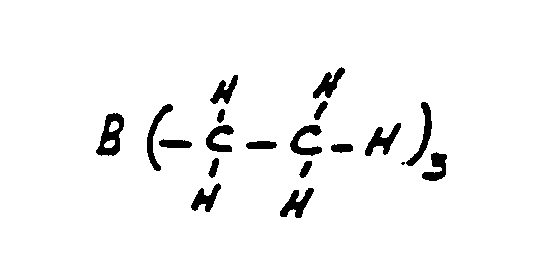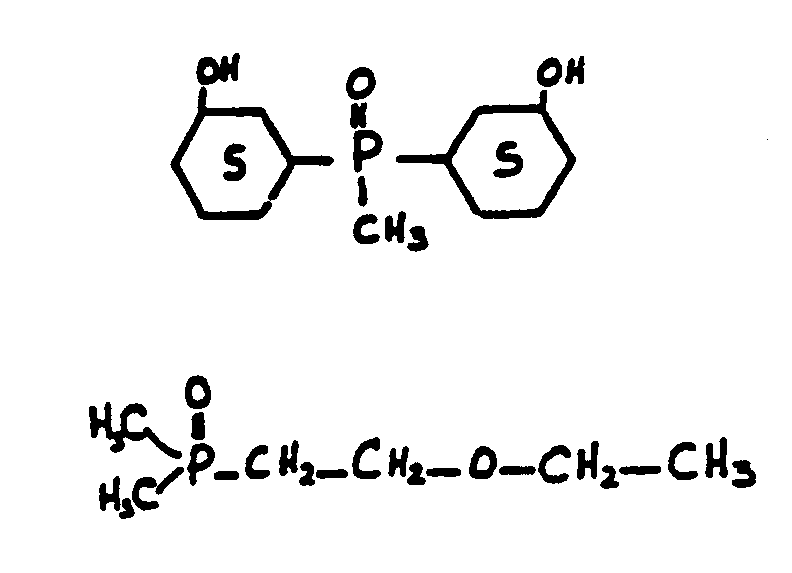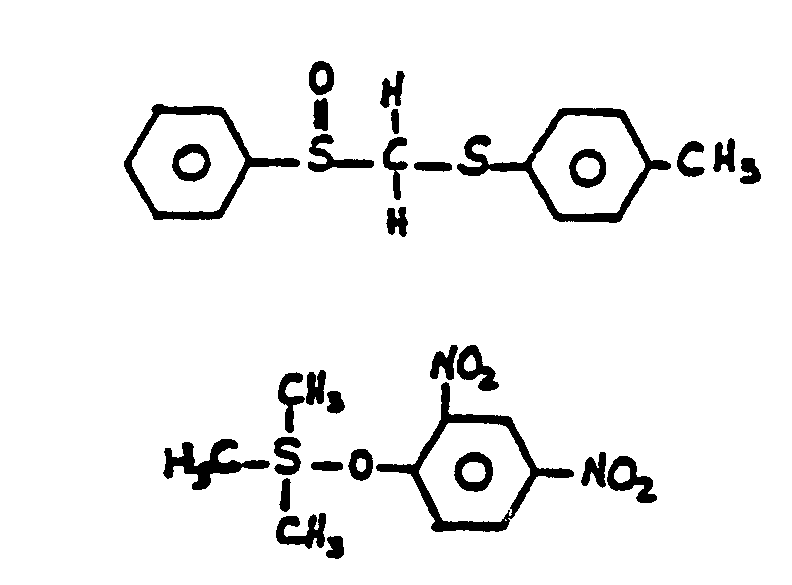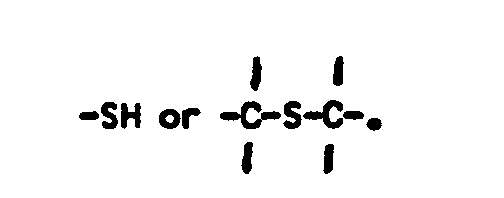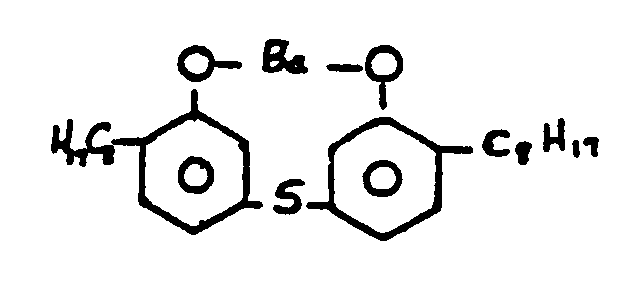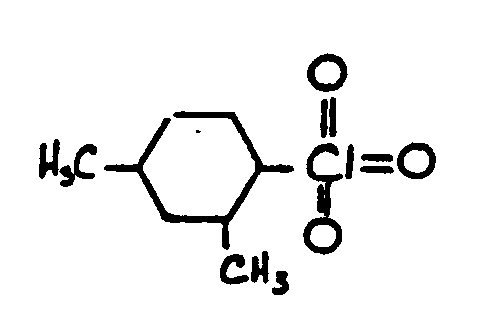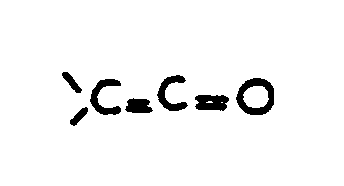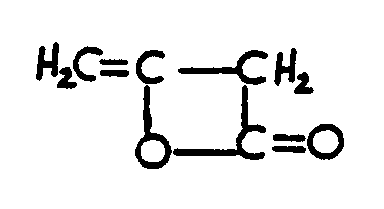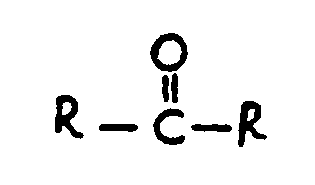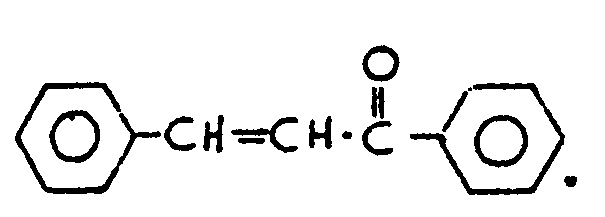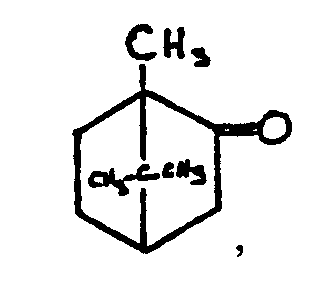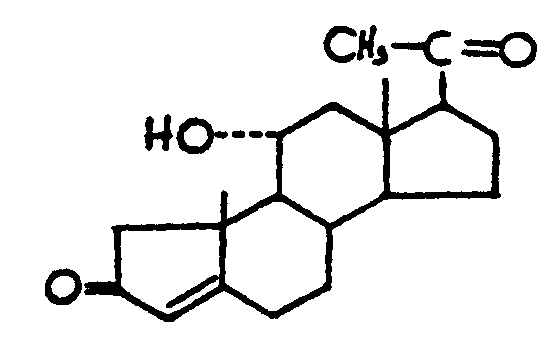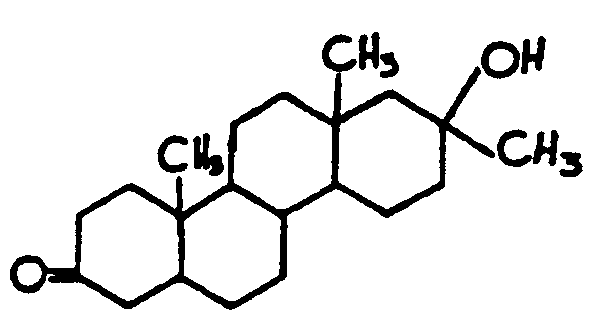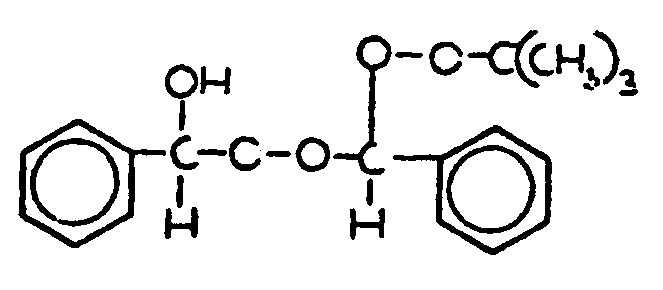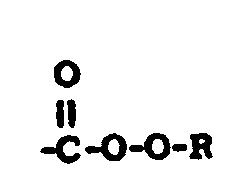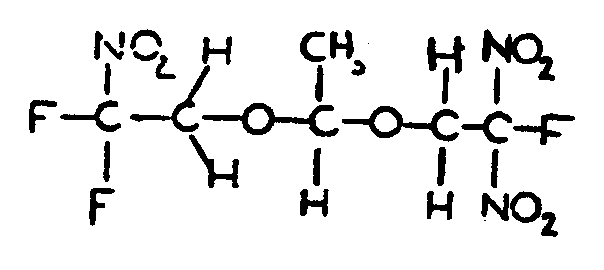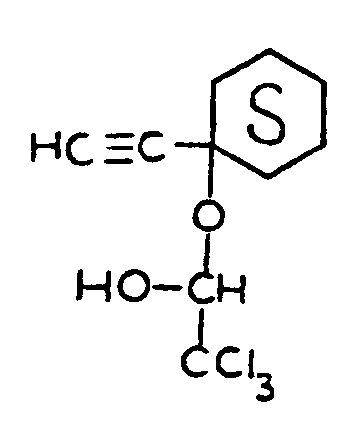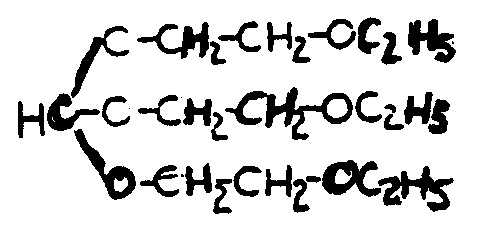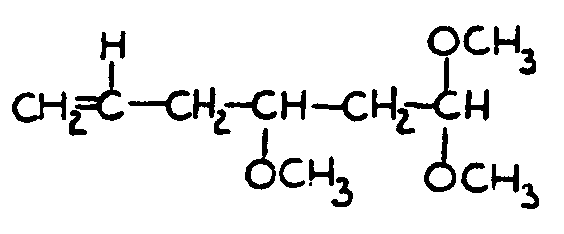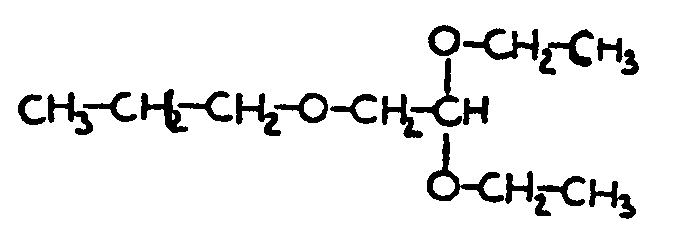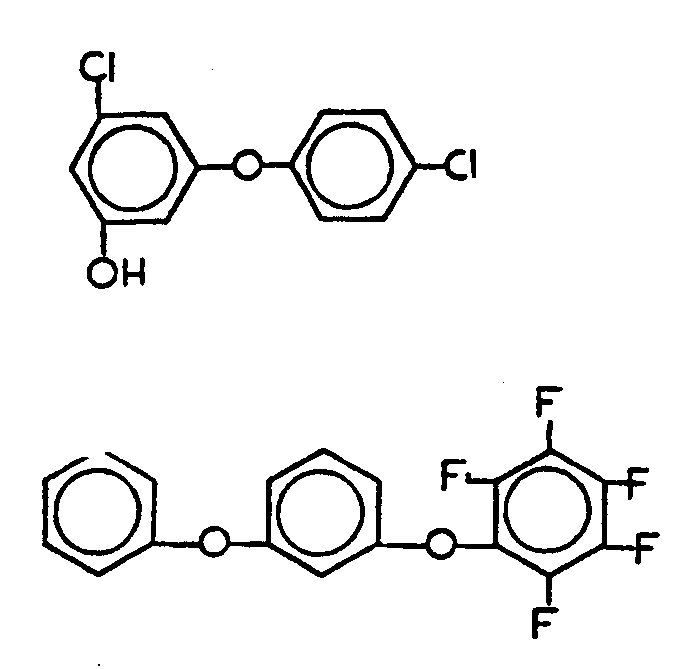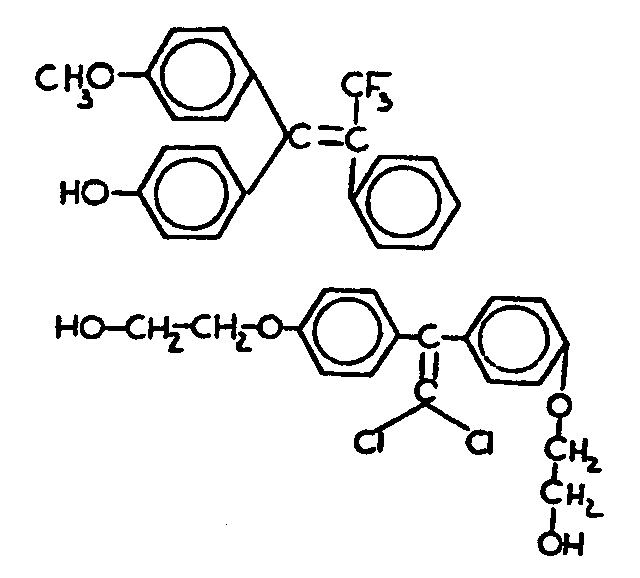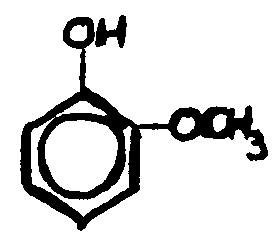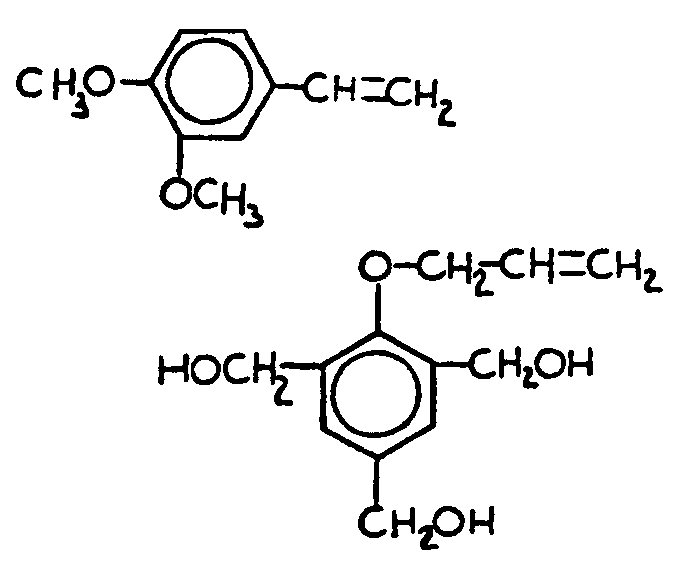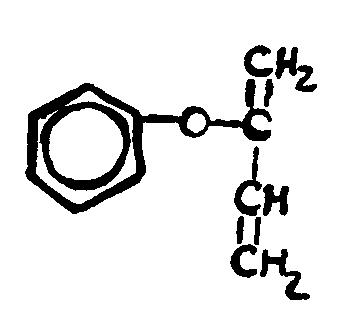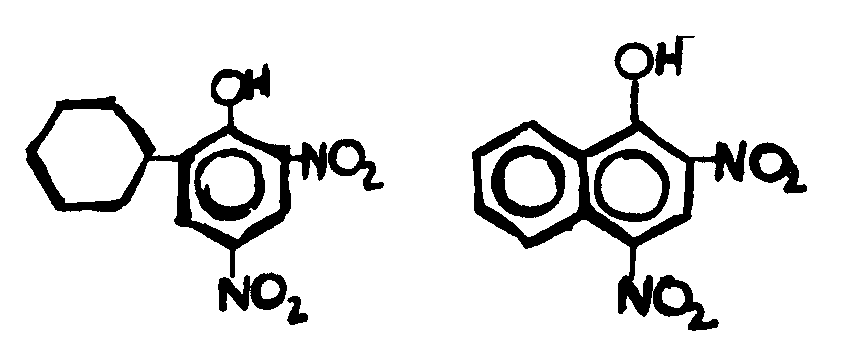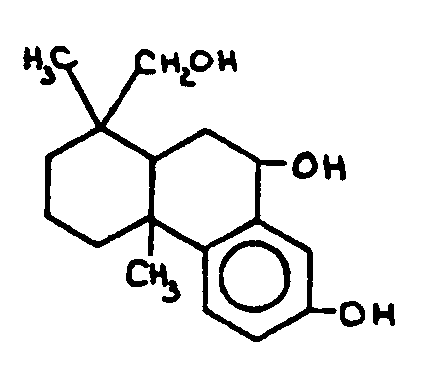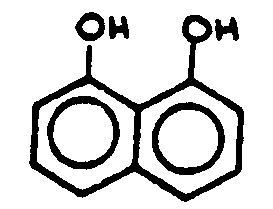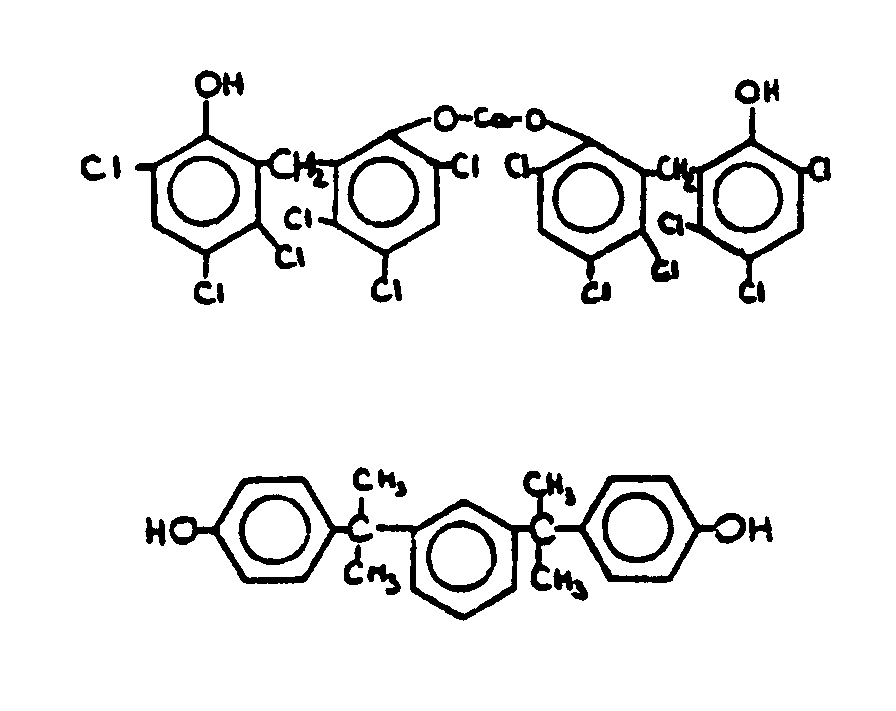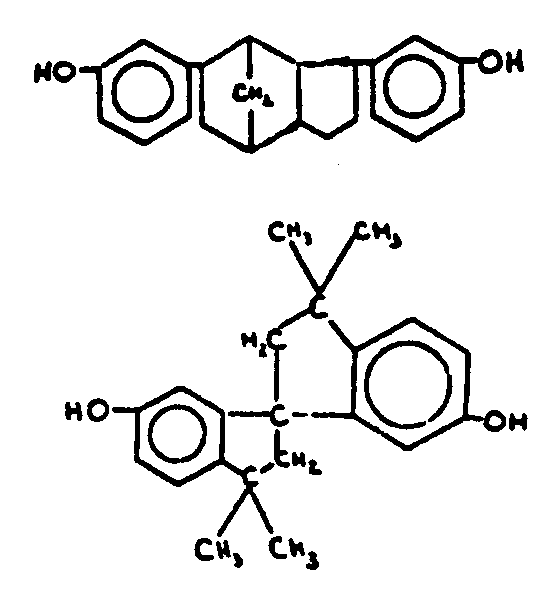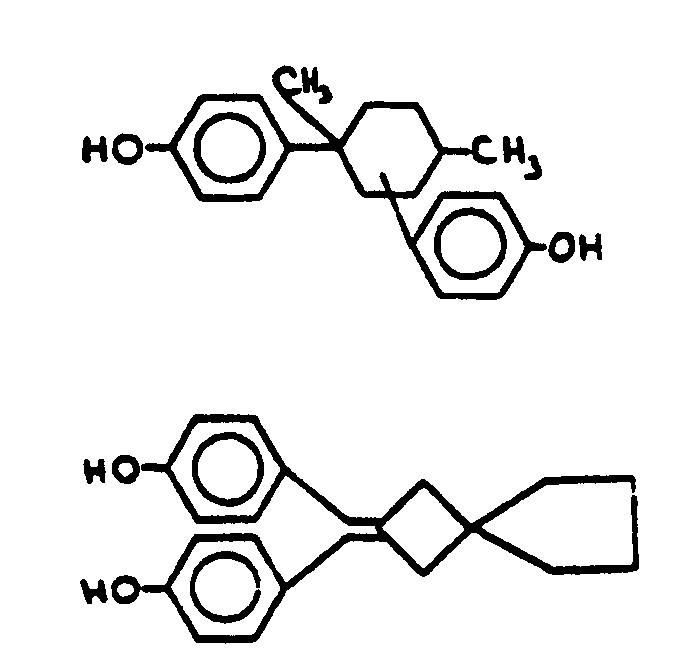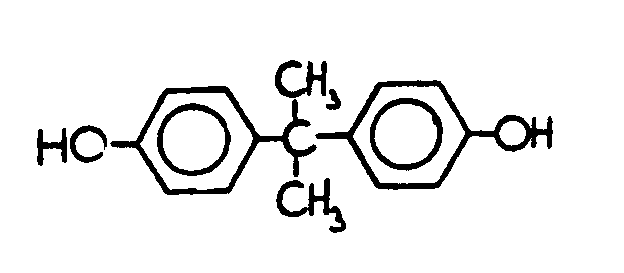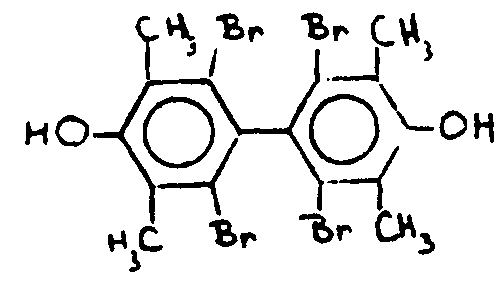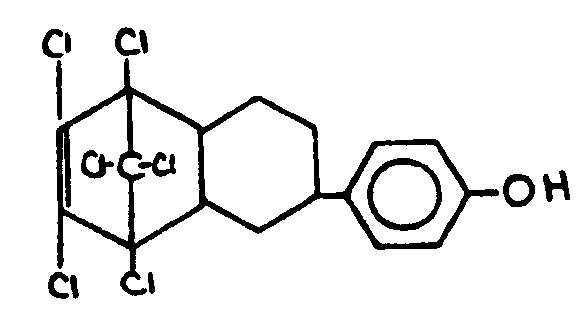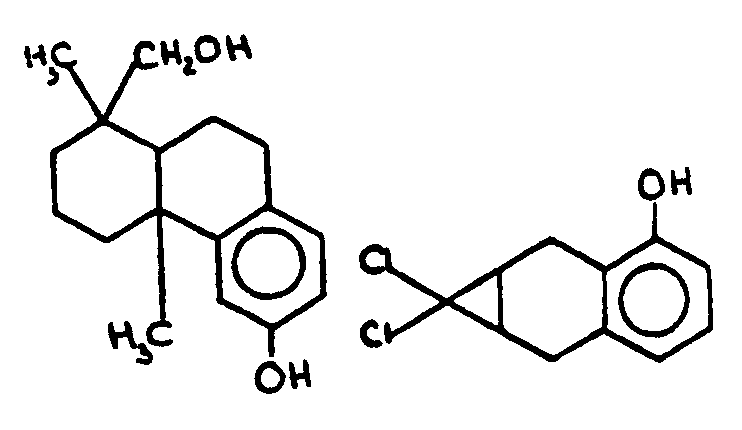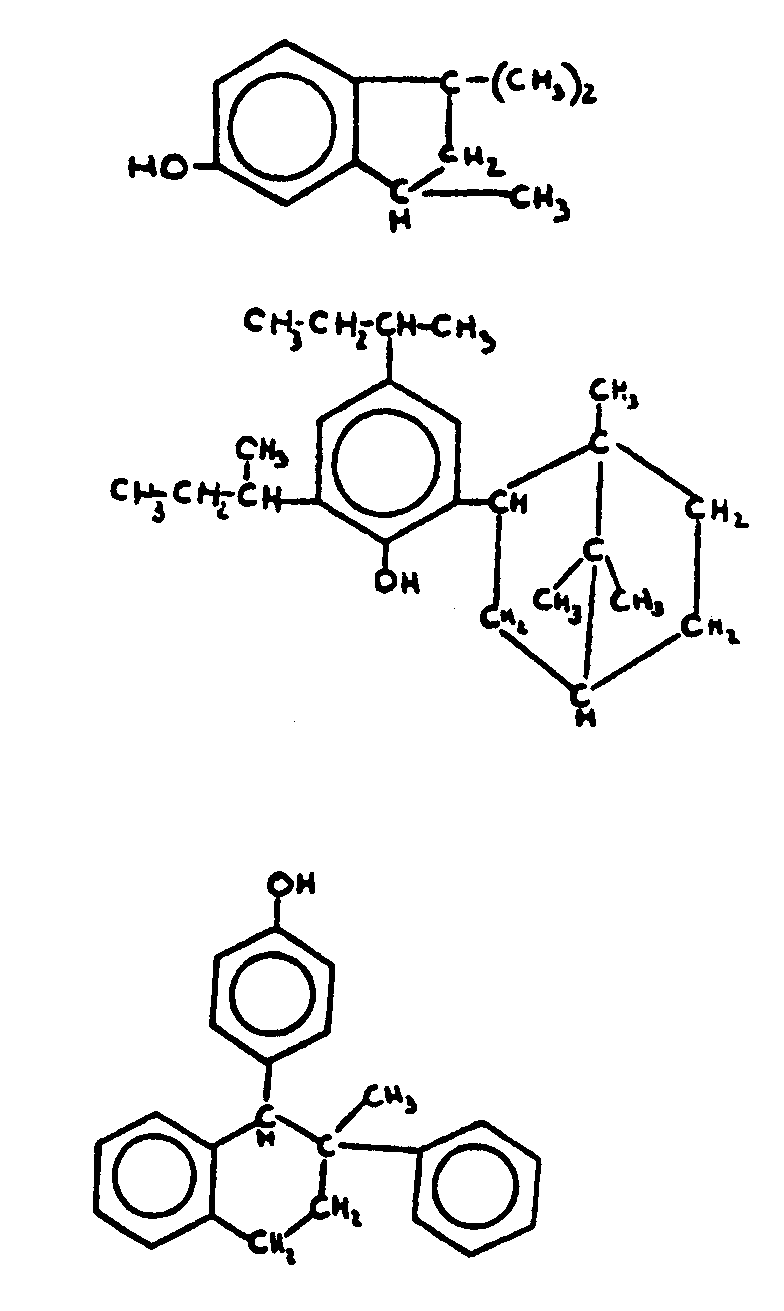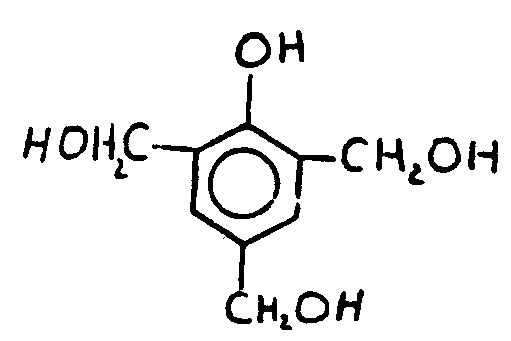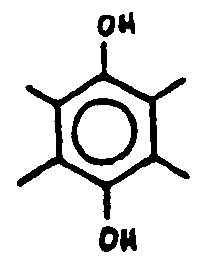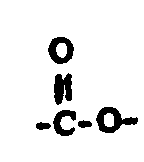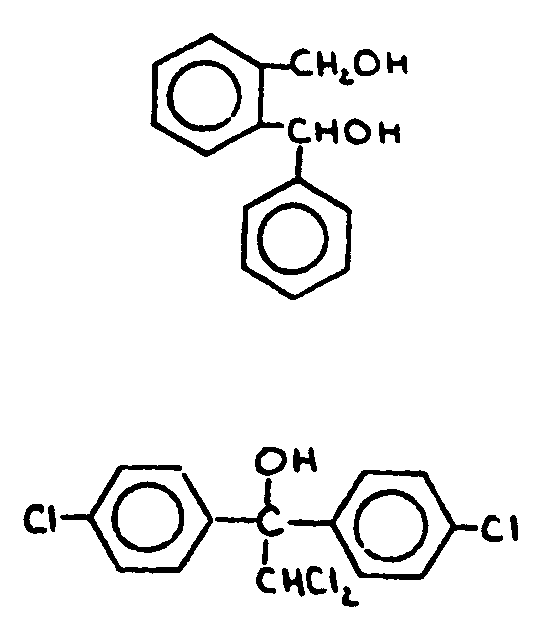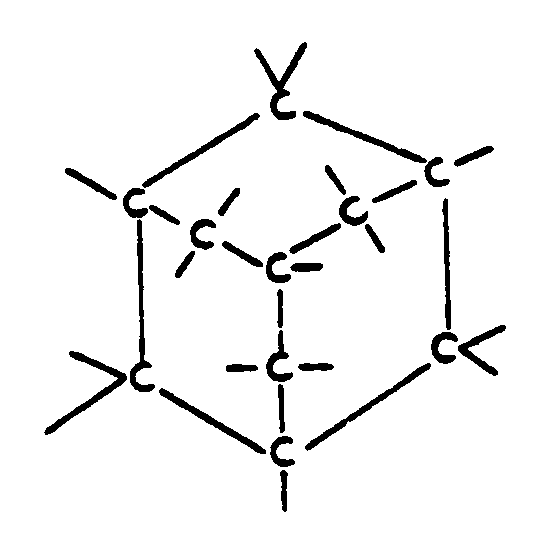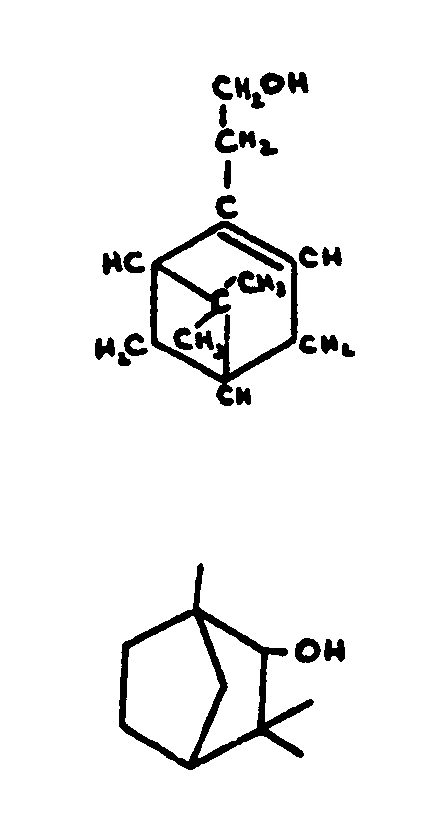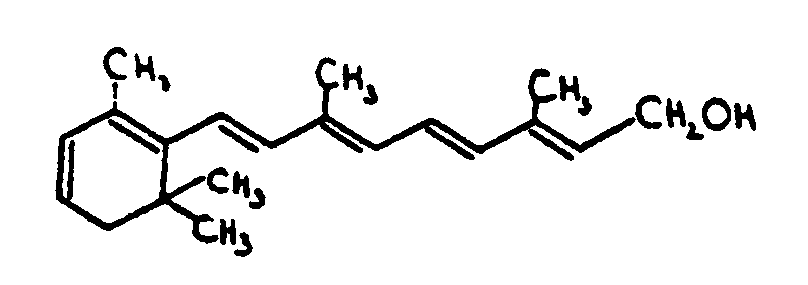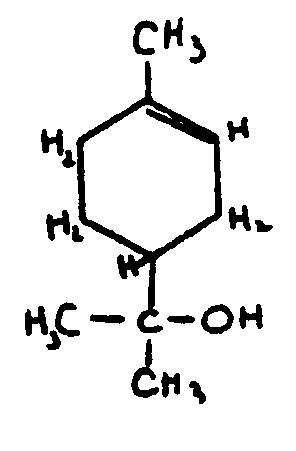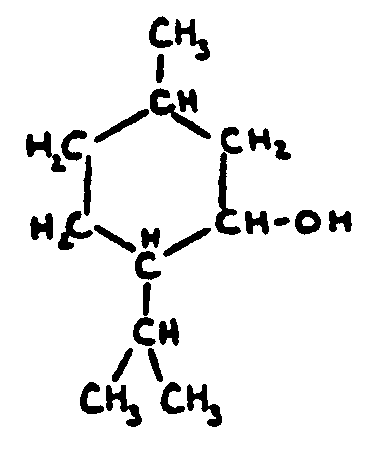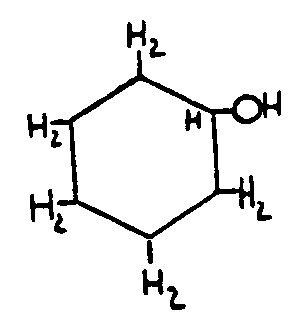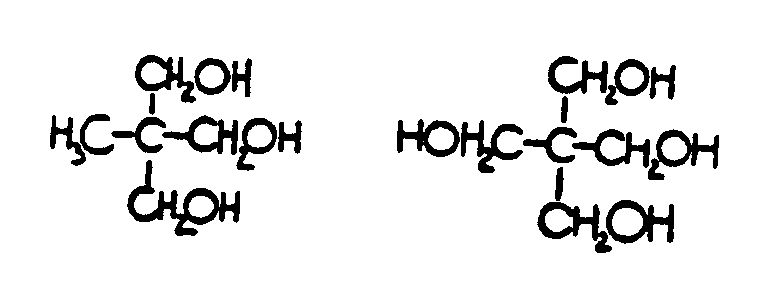![[Search a list of Patent Appplications for class 568]](../as.gif) CLASS 568, CLASS 568, | ORGANIC COMPOUNDS -- PART OF THE CLASS 532 - 570 SERIES |
| Click here for a printable version of this file | |
SECTION I - LINES WITH OTHER CLASSES AND WITHIN THIS CLASS
In this series of classes, class 568 is to be considered as an integral part of class 260 (after subclass 585) and follows the schedule hierarchy retaining all pertinent definitions and class lines of class 260.
SUBCLASSES
![[List of Patents for class 568 subclass 1]](../ps.gif) 1 1 | BORON CONTAINING | ||
| This subclass is indented under subclass 1. Compounds under Class 532, ... which contain boron.
SEE OR SEARCH CLASS:
| |||
![[List of Patents for class 568 subclass 2]](../ps.gif) 2 2 | Phosphorus containing |
| This subclass is indented under subclass 1. Compounds which contain phosphorus. | |
![[List of Patents for class 568 subclass 3]](../ps.gif) 3 3 | Plural borons containing | ||
This subclass is indented under subclass 1. Compounds which contain two or more boron atoms.
| |||
![[List of Patents for class 568 subclass 4]](../ps.gif) 4 4 | Ten or more borons containing (e.g., decaborane, etc.) |
| This subclass is indented under subclass 3. Compounds which contain at least ten boron atoms. | |
![[List of Patents for class 568 subclass 5]](../ps.gif) 5 5 | Sulfur, oxygen, halogen or Group IA or IIA light metal containing |
| This subclass is indented under subclass 4. Compounds which contain sulfur, oxygen, halogen, or a metal selected from Group IA or IIA of the Periodic Table having a specific gravity less than four. | |
![[List of Patents for class 568 subclass 6]](../ps.gif) 6 6 | Sulfur, oxygen, halogen or Group IA or IIA light metal containing |
| This subclass is indented under subclass 1. Compounds which contain sulfur, oxygen, halogen, or a metal selected from Group IA or IIA of the Periodic Table having a specific gravity less than four. | |
![[List of Patents for class 568 subclass 7]](../ps.gif) 7 7 | Tri-acyclic-hydrocarbyl boron | ||
This subclass is indented under subclass 1. Compounds which contain boron having three acyclic substituents
consisting of hydrogen and carbon.
| |||
![[List of Patents for class 568 subclass 8]](../ps.gif) 8 8 | PHOSPHORUS CONTAINING | ||
| This subclass is indented under subclass 1. Compounds under Class 532, ... which contain phosphorus.
SEE OR SEARCH CLASS:
| |||
![[List of Patents for class 568 subclass 9]](../ps.gif) 9 9 | Phosphonium derivative |
| This subclass is indented under subclass 8. Compounds wherein at least one hydrogen of the phosphonium radical PH4 is substituted by an organic radical. | |
![[List of Patents for class 568 subclass 10]](../ps.gif) 10 10 | Plural phosphori containing |
| This subclass is indented under subclass 9. Compounds which contain at least two phosphorus atoms. | |
![[List of Patents for class 568 subclass 11]](../ps.gif) 11 11 | Sulfur or oxygen containing |
| This subclass is indented under subclass 9. Compounds which contain sulfur or oxygen. | |
![[List of Patents for class 568 subclass 12]](../ps.gif) 12 12 | Ring phosphorus containing |
| This subclass is indented under subclass 8. Compounds in which phosphorus is a ring member. | |
![[List of Patents for class 568 subclass 13]](../ps.gif) 13 13 | Sulfur or oxygen containing |
| This subclass is indented under subclass 8. Compounds which contain sulfur or oxygen. | |
![[List of Patents for class 568 subclass 14]](../ps.gif) 14 14 | Sulfur or oxygen bonded directly to phosphorus |
| This subclass is indented under subclass 13. Compounds wherein sulfur or oxygen is bonded directly to phosphorus. | |
![[List of Patents for class 568 subclass 15]](../ps.gif) 15 15 | And sulfur or oxygen bonded indirectly to phosphorus | ||
This subclass is indented under subclass 14. Compounds which contain sulfur or oxygen bonded indirectly
to phosphorus.
| |||
![[List of Patents for class 568 subclass 16]](../ps.gif) 16 16 | Halogen containing |
| This subclass is indented under subclass 8. Compounds which contain halogen. | |
![[List of Patents for class 568 subclass 17]](../ps.gif) 17 17 | Benzene ring containing |
| This subclass is indented under subclass 8. Compounds which contain a benzene ring. | |
![[List of Patents for class 568 subclass 18]](../ps.gif) 18 18 | SULFUR CONTAINING | ||
| This subclass is indented under subclass 1. Compounds under Class 532, ... which contain sulfur.
SEE OR SEARCH CLASS:
| |||
![[List of Patents for class 568 subclass 19]](../ps.gif) 19 19 | With preservative or stabilizer |
| This subclass is indented under subclass 18. Products wherein the sulfur containing compound is mixed with a preserving or stabilizing agent which functions to prevent physical or chemical change. | |
![[List of Patents for class 568 subclass 20]](../ps.gif) 20 20 | Thiocarbonyl containing (e.g., thioketone containing, etc.) |
| This subclass is indented under subclass 18. Compounds which contain a | |
![[List of Patents for class 568 subclass 21]](../ps.gif) 21 21 | Sulfur bonded directly to sulfur (e.g., disulfides, etc.) |
| This subclass is indented under subclass 18. Compounds which contain sulfur directly bonded to sulfur. | |
![[List of Patents for class 568 subclass 22]](../ps.gif) 22 22 | Oxygen containing |
| This subclass is indented under subclass 21. Compounds which contain oxygen. | |
![[List of Patents for class 568 subclass 23]](../ps.gif) 23 23 | Sulfur or oxygen bonded directly to a ring |
| This subclass is indented under subclass 22. Compounds wherein sulfur or oxygen is bonded directly to a ring. | |
![[List of Patents for class 568 subclass 24]](../ps.gif) 24 24 | Halogen containing |
| This subclass is indented under subclass 21. Compounds which contain halogen. | |
![[List of Patents for class 568 subclass 25]](../ps.gif) 25 25 | Benzene ring containing |
| This subclass is indented under subclass 21. Compounds which contain a benzene ring. | |
![[List of Patents for class 568 subclass 26]](../ps.gif) 26 26 | Preparing by reacting a thiol or mercaptide (i.e., reactant contains -SH or -SM where M is a Group IA or IIA light metal) |
| This subclass is indented under subclass 21. Processes wherein the compound is prepared by reacting a compound containing a -SH or -SM group where M is a Group IA or IIA metal having a specific gravity less than four. | |
![[List of Patents for class 568 subclass 27]](../ps.gif) 27 27 | Oxygen bonded directly to sulfur (e.g., sulfoxides, etc.) | ||
This subclass is indented under subclass 18. Compounds which contain oxygen directly bonded to sulfur.
| |||
![[List of Patents for class 568 subclass 28]](../ps.gif) 28 28 | Plural oxygens bonded directly to the same sulfur (e.g., sulfones, etc.) |
| This subclass is indented under subclass 27. Compounds wherein at least two oxygens are directly bonded to the same sulfur atom. | |
![[List of Patents for class 568 subclass 29]](../ps.gif) 29 29 | Thiol or thioether containing |
| This subclass is indented under subclass 28. Compounds which contain
| |
![[List of Patents for class 568 subclass 30]](../ps.gif) 30 30 | Nitrogen containing |
| This subclass is indented under subclass 28. Compounds which contain nitrogen. | |
![[List of Patents for class 568 subclass 31]](../ps.gif) 31 31 | Carbonyl containing (e.g., ketone containing, etc.) |
| This subclass is indented under subclass 28. Compounds which contain a | |
![[List of Patents for class 568 subclass 32]](../ps.gif) 32 32 | Oxy containing |
| This subclass is indented under subclass 28. Compounds which contain oxy. | |
![[List of Patents for class 568 subclass 33]](../ps.gif) 33 33 | Oxy bonded directly to a ring |
| This subclass is indented under subclass 32. Compounds wherein oxy is bonded directly to a ring. | |
![[List of Patents for class 568 subclass 34]](../ps.gif) 34 34 | Plural rings containing |
| This subclass is indented under subclass 28. Compounds which contain at least two rings. | |
![[List of Patents for class 568 subclass 35]](../ps.gif) 35 35 | Plural halogens containing |
| This subclass is indented under subclass 28. Compounds which contain at least two halogen atoms. | |
![[List of Patents for class 568 subclass 36]](../ps.gif) 36 36 | Nitrogen or plural sulfurs containing |
| This subclass is indented under subclass 27. Compounds which contain nitrogen or at least two sulfur atoms. | |
| 37. | |
| This subclass is indented under subclass 27. Compounds which contain a | |
![[List of Patents for class 568 subclass 38]](../ps.gif) 38 38 | Thioethers |
| This subclass is indented under subclass 18. Compounds having the R-S-R structure wherein the R"s are diverse or identical organic radicals. | |
![[List of Patents for class 568 subclass 39]](../ps.gif) 39 39 | Oxygen containing |
| This subclass is indented under subclass 38. Compounds which contain oxygen. | |
![[List of Patents for class 568 subclass 40]](../ps.gif) 40 40 | Group IA or IIA light metal containing | ||
This subclass is indented under subclass 39. Compounds which contain a Group IA or IIA metal having a
specific gravity less than four.
| |||
![[List of Patents for class 568 subclass 41]](../ps.gif) 41 41 | Carbonyl containing (e.g., aldehyde containing, etc.) |
| This subclass is indented under subclass 39. Compounds which contain a | |
![[List of Patents for class 568 subclass 42]](../ps.gif) 42 42 | Ketone containing |
| This subclass is indented under subclass 41. Compounds which contain two organic radicals bonded directly to the carbonyl. | |
![[List of Patents for class 568 subclass 43]](../ps.gif) 43 43 | Oxy or halogen containing |
| This subclass is indented under subclass 42. Compounds which contain oxy or halogen. | |
![[List of Patents for class 568 subclass 44]](../ps.gif) 44 44 | Nitrogen containing |
| This subclass is indented under subclass 39. Compounds which contain nitrogen. | |
![[List of Patents for class 568 subclass 45]](../ps.gif) 45 45 | Plural oxygens containing |
| This subclass is indented under subclass 39. Compounds which contain two or more oxygen atoms. | |
![[List of Patents for class 568 subclass 46]](../ps.gif) 46 46 | Polyhydroxy |
| This subclass is indented under subclass 45. Compounds which contain two or more -OH groups. | |
![[List of Patents for class 568 subclass 47]](../ps.gif) 47 47 | Plural rings containing |
| This subclass is indented under subclass 46. Compounds which contain at least two rings. | |
![[List of Patents for class 568 subclass 48]](../ps.gif) 48 48 | Plural rings bonded directly to the same sulfur |
| This subclass is indented under subclass 47. Compounds wherein at least two rings are bonded directly to the same sulfur atom. | |
![[List of Patents for class 568 subclass 49]](../ps.gif) 49 49 | Plural rings containing |
| This subclass is indented under subclass 45. Compounds which contain at least two rings. | |
![[List of Patents for class 568 subclass 50]](../ps.gif) 50 50 | Thiol or plural thioethers containing |
| This subclass is indented under subclass 45. Compounds which contain at least one -SH group or two or
more
| |
![[List of Patents for class 568 subclass 51]](../ps.gif) 51 51 | Oxygen bonded directly to a ring |
| This subclass is indented under subclass 39. Compounds wherein oxygen is directly bonded to a ring. | |
![[List of Patents for class 568 subclass 52]](../ps.gif) 52 52 | Plural rings containing |
| This subclass is indented under subclass 51. Compounds which contain two or more rings. | |
![[List of Patents for class 568 subclass 53]](../ps.gif) 53 53 | Plural rings bonded directly to the same sulfur |
| This subclass is indented under subclass 52. Compounds wherein at least two rings are bonded directly to the same sulfur atoms. | |
![[List of Patents for class 568 subclass 54]](../ps.gif) 54 54 | Sulfur bonded directly to a ring |
| This subclass is indented under subclass 51. Compounds wherein sulfur is directly bonded to a ring. | |
![[List of Patents for class 568 subclass 55]](../ps.gif) 55 55 | Hydroxy containing |
| This subclass is indented under subclass 39. Compounds which contain an -OH group. | |
![[List of Patents for class 568 subclass 56]](../ps.gif) 56 56 | Halogen containing |
| This subclass is indented under subclass 38. Compounds which contain halogen. | |
![[List of Patents for class 568 subclass 57]](../ps.gif) 57 57 | Thiol or plural thioethers containing |
| This subclass is indented under subclass 38. Compounds which contain at least one -SH group or two or more R-S-R groups. | |
![[List of Patents for class 568 subclass 58]](../ps.gif) 58 58 | Plural rings containing |
| This subclass is indented under subclass 38. Compounds which contain two or more rings. | |
![[List of Patents for class 568 subclass 59]](../ps.gif) 59 59 | Acyclic |
| This subclass is indented under subclass 38. Compounds which do not include a ring. | |
![[List of Patents for class 568 subclass 60]](../ps.gif) 60 60 | Symmetrical (e.g., dimethyl sulfide, etc.) |
| This subclass is indented under subclass 59. Compounds wherein the R groups in R-S-R are identical acyclic groups. | |
![[List of Patents for class 568 subclass 61]](../ps.gif) 61 61 | Thiol or mercaptide containing (i.e., -SH or -SM containing where M is a Group IA or IIA light metal) |
| This subclass is indented under subclass 18. Compounds which contain a -SH or -SM group where M is a Group IA or IIA metal having a specific gravity less than four. | |
![[List of Patents for class 568 subclass 62]](../ps.gif) 62 62 | Oxygen containing |
| This subclass is indented under subclass 61. Compounds which contain oxygen. | |
![[List of Patents for class 568 subclass 63]](../ps.gif) 63 63 | Carbonyl containing (e.g., ketone containing, etc.) |
| This subclass is indented under subclass 62. Compounds which contain the following g roup: | |
![[List of Patents for class 568 subclass 64]](../ps.gif) 64 64 | Oxygen bonded directly to a ring |
| This subclass is indented under subclass 62. Compounds wherein oxygen is directly bonded to a ring. | |
![[List of Patents for class 568 subclass 65]](../ps.gif) 65 65 | Halogen containing |
| This subclass is indented under subclass 61. Compounds which contain halogen. | |
![[List of Patents for class 568 subclass 66]](../ps.gif) 66 66 | Polythiol |
| This subclass is indented under subclass 61. Compounds which contain two or more -SH groups. | |
![[List of Patents for class 568 subclass 67]](../ps.gif) 67 67 | Benzene ring containing |
| This subclass is indented under subclass 61. Compounds which contain a benzene ring. | |
![[List of Patents for class 568 subclass 68]](../ps.gif) 68 68 | Preparing by utilizing halogen, heavy metal, or aluminum containing material |
| This subclass is indented under subclass 67. Processes wherein the compound is prepared by utilizing a halogen containing, heavy metal containing, or aluminum containing material in any way, e.g., as a catalyst, reactant, etc. | |
![[List of Patents for class 568 subclass 69]](../ps.gif) 69 69 | Acyclic |
| This subclass is indented under subclass 61. Compounds which do not include a ring. | |
![[List of Patents for class 568 subclass 70]](../ps.gif) 70 70 | Preparing by reacting hydrogen sulfide or a metal hydrosulfide |
| This subclass is indented under subclass 69. Processes wherein the compound is prepared by reacting hydrogen sulfide or a hydrosulfide or a metal, e.g., reacting H2S or NaSH. | |
![[List of Patents for class 568 subclass 71]](../ps.gif) 71 71 | And an organic hydroxy containing reactant (H of -OH may be replaced by a Group IA or IIA light metal) |
| This subclass is indented under subclass 70. Processes wherein the compound is prepared by reacting hydrogen sulfide or a metal hydrosulfide and an organic hydroxy-containing compound. | |
![[List of Patents for class 568 subclass 72]](../ps.gif) 72 72 | And a reactant having carbon to carbon unsaturation |
| This subclass is indented under subclass 70. Processes wherein the compound is prepared by reacting hydrogen sulfide or a metal hydrosulfide and a compound containing carbon to carbon unsaturation. | |
![[List of Patents for class 568 subclass 73]](../ps.gif) 73 73 | Boron, phosphorus, or silicon containing material utilized |
| This subclass is indented under subclass 72. Processes wherein a material containing boron, phosphorus, or silicon is utilized in any way, e.g., as a catalyst, reactant, etc. | |
![[List of Patents for class 568 subclass 74]](../ps.gif) 74 74 | Halogen containing |
| This subclass is indented under subclass 18. Compounds which contain halogen. | |
![[List of Patents for class 568 subclass 75]](../ps.gif) 75 75 | Oxygen containing | ||
| This subclass is indented under subclass 18. Compounds which contain oxygen.
SEE OR SEARCH THIS CLASS, SUBCLASS:
| |||
![[List of Patents for class 568 subclass 76]](../ps.gif) 76 76 | Nitro or nitroso containing |
| This subclass is indented under subclass 75. Compounds which contain a nitro (-NO) or nitrosos (-NO) group. | |
![[List of Patents for class 568 subclass 77]](../ps.gif) 77 77 | Ring containing |
| This subclass is indented under subclass 18. Compounds which contain a carbocyclic ring. | |
![[List of Patents for class 568 subclass 300]](../ps.gif) 300 300 | OXYGEN CONTAINING (E.G., PERCHLORYLBENZENE, ETC.) | ||||
This subclass is indented under subclass 1. Compounds under Class 532, ... which contain oxygen.
SEE OR SEARCH CLASS:
| |||||
![[List of Patents for class 568 subclass 301]](../ps.gif) 301 301 | Ketenes (e.g., halogenated ketenes, etc.) | ||
| This subclass is indented under subclass 300. Compounds which contain the following structure:
SEE OR SEARCH CLASS:
| |||
![[List of Patents for class 568 subclass 302]](../ps.gif) 302 302 | Ketene per se (i.e., HCH=C=O) |
| This subclass is indented under subclass 301. Compounds which contain the following structure:
| |
![[List of Patents for class 568 subclass 303]](../ps.gif) 303 303 | Ketones |
| This subclass is indented under subclass 300. Compounds having the following structure wherein the R"s
are diverse or identical organic radicals:
| |
![[List of Patents for class 568 subclass 304]](../ps.gif) 304 304 | With preservative or stabilizer |
| This subclass is indented under subclass 303. Products wherein the ketone is mixed with a preserving or stabilizing agent which functions to prevent physical or chemical change. | |
![[List of Patents for class 568 subclass 305]](../ps.gif) 305 305 | Nitrogen containing |
| This subclass is indented under subclass 303. Compounds which contain nitrogen. | |
![[List of Patents for class 568 subclass 306]](../ps.gif) 306 306 | Benzene ring containing |
| This subclass is indented under subclass 305. Compounds which contain a benzene ring. | |
![[List of Patents for class 568 subclass 307]](../ps.gif) 307 307 | Acyclic |
| This subclass is indented under subclass 305. Compounds which do not include a ring. | |
![[List of Patents for class 568 subclass 308]](../ps.gif) 308 308 | Benzene ring containing |
| This subclass is indented under subclass 303. Compounds which contain a benzene ring. | |
![[List of Patents for class 568 subclass 309]](../ps.gif) 309 309 | Processes |
| This subclass is indented under subclass 308. Processes which are directed to the preparation, purification, recovery, or treatment in any way of a benzene ring containing ketone. | |
![[List of Patents for class 568 subclass 310]](../ps.gif) 310 310 | Isomerization |
| This subclass is indented under subclass 309. Processes wherein the compound is prepared by transformation or rearrangement of the elements of a starting compound without adding or taking away any elements. | |
![[List of Patents for class 568 subclass 311]](../ps.gif) 311 311 | Carbon monoxide or peroxy containing reactant |
| This subclass is indented under subclass 309. Processes wherein the compound is prepared by reacting CO or by reacting a compound which contains a -O-O- group. | |
![[List of Patents for class 568 subclass 312]](../ps.gif) 312 312 | Aldehyde or ketone reactant |
| This subclass is indented under subclass 309. Processes wherein the compound is prepared by reacting an aldehyde or ketone. | |
![[List of Patents for class 568 subclass 313]](../ps.gif) 313 313 | Aldehyde reacted with ketone |
| This subclass is indented under subclass 312. Processes wherein the compound is prepared by reacting an aldehyde with a ketone. | |
![[List of Patents for class 568 subclass 314]](../ps.gif) 314 314 | Reactant contains -COO- group |
| This subclass is indented under subclass 312. Processes wherein the compound is prepared by reacting an aldehyde or ketone and a compound containing a -COO- group, or by reacting an aldehyde or ketone which contains a -COO- group. | |
![[List of Patents for class 568 subclass 315]](../ps.gif) 315 315 | Oxy containing reactant |
| This subclass is indented under subclass 312. Processes wherein the compound is prepared by reacting an aldehyde or ketone and an oxy containing compound, or by reacting an oxy containing aldehyde or ketone. | |
![[List of Patents for class 568 subclass 316]](../ps.gif) 316 316 | Halogen containing reactant |
| This subclass is indented under subclass 312. Processes wherein the compound is prepared by reacting an aldehyde or ketone and a halogen containing compound, or by reacting a halogen containing aldehyde or ketone. | |
![[List of Patents for class 568 subclass 317]](../ps.gif) 317 317 | Alicyclic unsaturated or acyclic unsaturated hydrocarbon reactant |
| This subclass is indented under subclass 312. Processes wherein the compound is prepared by reacting an aldehyde or ketone and an unsaturated alicyclic hydrocarbon or an unsaturated acyclic hydrocarbon. | |
![[List of Patents for class 568 subclass 318]](../ps.gif) 318 318 | Gaseous hydrogen reactant or Group IA or IIA light metal containing material utilized | ||
This subclass is indented under subclass 312. Processes wherein the compound is prepared by reacting an
aldehyde or ketone and gaseous hydrogen or wherein the compound
is prepared from an aldehyde or ketone utilizing a material containing
a Group IA or IIA metal having a specific gravity less than four
in any way, e.g., as a reactant, catalyst, solvent, etc.
| |||
![[List of Patents for class 568 subclass 319]](../ps.gif) 319 319 | Reactant contains -COO- group |
| This subclass is indented under subclass 309. Processes wherein the compound is prepared by reacting a compound containing a -COO- group, e.g., a carboxylic acid, ester, or anhydride. | |
![[List of Patents for class 568 subclass 320]](../ps.gif) 320 320 | Oxidation of organic compound utilizing gaseous oxygen |
| This subclass is indented under subclass 309. Processes wherein the compound is prepared by oxidizing an organic compound utilizing gaseous oxygen. | |
![[List of Patents for class 568 subclass 321]](../ps.gif) 321 321 | Plural rings in ketone prepared |
| This subclass is indented under subclass 320. Processes which include preparing a compound containing two or more rings. | |
![[List of Patents for class 568 subclass 322]](../ps.gif) 322 322 | Oxy containing reactant |
| This subclass is indented under subclass 309. Processes wherein the compound is prepared by reacting an oxy containing compound. | |
![[List of Patents for class 568 subclass 323]](../ps.gif) 323 323 | Halogen containing reactant (e.g., dehydrohalogenation, etc.) |
| This subclass is indented under subclass 309. Processes wherein the compound is prepared by reacting a halogen containing compound. | |
![[List of Patents for class 568 subclass 324]](../ps.gif) 324 324 | Purification or recovery |
| This subclass is indented under subclass 309. Processes which include separating the compound from impurities or from the reaction mixture. | |
![[List of Patents for class 568 subclass 325]](../ps.gif) 325 325 | Plural rings containing |
| This subclass is indented under subclass 308. Compounds which contain at least two rings. | |
![[List of Patents for class 568 subclass 326]](../ps.gif) 326 326 | Polycyclo ring system |
| This subclass is indented under subclass 325. Compounds which contain a polycyclo ring system. | |
![[List of Patents for class 568 subclass 327]](../ps.gif) 327 327 | Bicyclo ring system |
| This subclass is indented under subclass 326. Compounds wherein the polycyclo ring system consists of two rings. | |
![[List of Patents for class 568 subclass 328]](../ps.gif) 328 328 | Naphthyl ring system |
| This subclass is indented under subclass 327. Compounds wherein the bicyclo ring system is the naphthyl ring system. | |
![[List of Patents for class 568 subclass 329]](../ps.gif) 329 329 | Alicyclic ring containing |
| This subclass is indented under subclass 325. Compounds which contain at least one alicyclic ring. | |
![[List of Patents for class 568 subclass 330]](../ps.gif) 330 330 | Five-membered alicyclic ring |
| This subclass is indented under subclass 329. Compounds which contain a five-membered alicyclic ring. | |
![[List of Patents for class 568 subclass 331]](../ps.gif) 331 331 | Carbonyl bonded directly to benzene ring |
| This subclass is indented under subclass 325. Compounds which contain a | |
![[List of Patents for class 568 subclass 332]](../ps.gif) 332 332 | Two benzene rings bonded directly to the same carbonyl (i.e., benzophenones) |
| This subclass is indented under subclass 331. Compounds wherein two benzene rings are directly bonded to the same | |
![[List of Patents for class 568 subclass 333]](../ps.gif) 333 333 | Oxy containing |
| This subclass is indented under subclass 332. Compounds which contain oxy. | |
![[List of Patents for class 568 subclass 334]](../ps.gif) 334 334 | Chalcones |
| This subclass is indented under subclass 331. Compounds which contain the 1,3-dipheny1-2-propen-1 one
nucleus,
| |
![[List of Patents for class 568 subclass 335]](../ps.gif) 335 335 | Carbonyl bonded directly to benzene ring (i.e., acetophenones) |
| This subclass is indented under subclass 308. Compounds wherein is bonded directly to the benzene ring. | |
![[List of Patents for class 568 subclass 336]](../ps.gif) 336 336 | Oxy containing |
| This subclass is indented under subclass 335. Compounds which contain oxy. | |
![[List of Patents for class 568 subclass 337]](../ps.gif) 337 337 | Oxy bonded directly to benzene ring |
| This subclass is indented under subclass 336. Compounds wherein the oxy is directly bonded to the benzene ring. | |
![[List of Patents for class 568 subclass 338]](../ps.gif) 338 338 | Processes of preparing, purifying, or recovering alicyclic ring containing ketones |
| This subclass is indented under subclass 303. Processes which are directly to the preparation, purification, recovery, or treatment of an alicyclic ring containing ketone. | |
![[List of Patents for class 568 subclass 339]](../ps.gif) 339 339 | Camphor per se or salt thereof |
| This subclass is indented under subclass 338. Processes which are directly to the preparation, purification,
recovery, or treatment of camphor (see below) or a salt thereof.
| |
![[List of Patents for class 568 subclass 340]](../ps.gif) 340 340 | Purification or recovery |
| This subclass is indented under subclass 339. Processes which include separating the compound from impurites or from the reaction mixture. | |
![[List of Patents for class 568 subclass 341]](../ps.gif) 341 341 | Isomerization |
| This subclass is indented under subclass 338. Processes wherein the compound is produced by transformation or rearrangement of the elements of a starting compound without adding or taking away any elements. | |
![[List of Patents for class 568 subclass 342]](../ps.gif) 342 342 | Carbon monoxide or peroxy containing reactant |
| This subclass is indented under subclass 338. Processes wherein the compound is produced by reacting CO or by reacting a compound which contains a -O-O- group. | |
![[List of Patents for class 568 subclass 343]](../ps.gif) 343 343 | Aldehyde or ketone reactant |
| This subclass is indented under subclass 338. Processes wherein the compound is produced by reacting an aldehyde or ketone. | |
![[List of Patents for class 568 subclass 344]](../ps.gif) 344 344 | Oxidation utilizing gaseous oxygen | ||
This subclass is indented under subclass 343. Processes wherein the compound is produced by oxidizing
an aldehyde or ketone utilizing gaseous oxygen.
| |||
![[List of Patents for class 568 subclass 345]](../ps.gif) 345 345 | Aldehyde reacted with ketone |
| This subclass is indented under subclass 343. Processes wherein the compound is produced by reacting an aldehyde with a ketone. | |
![[List of Patents for class 568 subclass 346]](../ps.gif) 346 346 | Reactant contains -COO- group |
| This subclass is indented under subclass 343. Processes wherein the compound is produced by reacting an aldehyde of ketone with a compound containing a -COO- group, or by reacting an aldehyde or ketone which contains such a group. | |
![[List of Patents for class 568 subclass 347]](../ps.gif) 347 347 | Oxy containing reactant |
| This subclass is indented under subclass 343. Processes wherein the compound is prepared by reacting an aldehyde or ketone and an oxy containing compound, or by reacting an oxy containing aldehyde or ketone. | |
![[List of Patents for class 568 subclass 348]](../ps.gif) 348 348 | Halogen containing reactant |
| This subclass is indented under subclass 343. Processes wherein the compound is prepared by reacting an aldehyde or ketone and a halogen containing compound, or by reacting a halogen containing aldehyde or ketone. | |
![[List of Patents for class 568 subclass 349]](../ps.gif) 349 349 | Acyclic unsaturated hydrocarbon reactant |
| This subclass is indented under subclass 343. Processes wherein the compound is prepared by reacting an aldehyde or ketone and an acyclic unsaturated hydrocarbon. | |
![[List of Patents for class 568 subclass 350]](../ps.gif) 350 350 | Gaseous hydrogen reactant or Group IA or IIA light metal containing material utilized | ||
This subclass is indented under subclass 343. Processes wherein the compound is prepared by reacting an
aldehyde or ketone and gaseous hydrogen or wherein the compound
is prepared from an aldehyde or ketone utilizing a material containing
a Group IA or IIA metal having a specific gravity less than four
in any way, e.g., as a reactant, catalyst, solvent, etc.
| |||
![[List of Patents for class 568 subclass 351]](../ps.gif) 351 351 | Nitrogen containing material utilized |
| This subclass is indented under subclass 343. Processes wherein the compound is prepared from an aldehyde or ketone utilizing a material containing nitrogen in any way, e.g., as a reactant, catalyst, solvent, etc. | |
![[List of Patents for class 568 subclass 352]](../ps.gif) 352 352 | Boron, phosphorus, or sulfur containing material utilized |
| This subclass is indented under subclass 343. Processes wherein the compound is prepared from an aldehyde or ketone utilizing a material containing boron, phosphorus, or sulfur in any way, e.g., as a reactant, catalyst, solvent, etc. | |
![[List of Patents for class 568 subclass 353]](../ps.gif) 353 353 | Ketone reacted with ketone |
| This subclass is indented under subclass 343. Processes wherein the compound is prepared by reacting two or more ketones together. | |
![[List of Patents for class 568 subclass 354]](../ps.gif) 354 354 | Reactant contains -COO- group |
| This subclass is indented under subclass 338. Processes wherein the compound is prepared by reacting a compound containing a -COO- group, e.g., a carboxylic acid, ester or anhydride. | |
![[List of Patents for class 568 subclass 355]](../ps.gif) 355 355 | Plural -COO- groups in the reactant |
| This subclass is indented under subclass 354. Processes wherein the compound is prepared by reacting a compound containing at least two -COO- groups. | |
![[List of Patents for class 568 subclass 356]](../ps.gif) 356 356 | Carbon to carbon unsaturation in the reactant |
| This subclass is indented under subclass 354. Processes wherein the -COO- containing reactant contains an unsaturated carbon to carbon linkage. | |
![[List of Patents for class 568 subclass 357]](../ps.gif) 357 357 | Oxidation of organic compound utilizing gaseous oxygen |
| This subclass is indented under subclass 338. Processes wherein the compound is prepared by oxidizing an organic compound utilizing gaseous oxygen. | |
![[List of Patents for class 568 subclass 358]](../ps.gif) 358 358 | Plural stages each having oxidation |
| Processes under sublass 357 which include preparing the compound in two or more stages or zones, each including oxidation with gaseous oxygen. | |
![[List of Patents for class 568 subclass 359]](../ps.gif) 359 359 | Boron containing material utilized |
| This subclass is indented under subclass 357. Processes which include oxidizing an organic compound with gaseous oxygen utilizing a boron containing material in any way, e.g., as a catalyst, reactant, solvent, etc. | |
![[List of Patents for class 568 subclass 360]](../ps.gif) 360 360 | Heavy metal containing material utilized |
| This subclass is indented under subclass 357. Processes which include oxidizing an organic compound with gaseous oxygen utilizing a material which contains a metal having a specific gravity greater than four in any way, e.g., as a catalyst, reactant, etc. | |
![[List of Patents for class 568 subclass 361]](../ps.gif) 361 361 | Oxy containing reactant |
| This subclass is indented under subclass 338. Processes wherein the compound is prepared by reacting an oxy containing compound. | |
![[List of Patents for class 568 subclass 362]](../ps.gif) 362 362 | Phenol containing reactant |
| This subclass is indented under subclass 361. Processes wherein the oxy containing compound is a phenol. | |
![[List of Patents for class 568 subclass 363]](../ps.gif) 363 363 | Inorganic oxygen containing reactant |
| This subclass is indented under subclass 361. Processes which include preparing the compound by reacting an oxy containing compound and an inorganic oxygen containing compound. | |
![[List of Patents for class 568 subclass 364]](../ps.gif) 364 364 | Halogen containing reactant |
| This subclass is indented under subclass 338. Processes wherein the compound is prepared by reacting a halogen containing compound. | |
![[List of Patents for class 568 subclass 365]](../ps.gif) 365 365 | Unsaturated hydrocarbon reactant |
| This subclass is indented under subclass 338. Processes wherein the compound is prepared by reacting an ethylenically or acetylenically unsaturated hydrocarbon. | |
![[List of Patents for class 568 subclass 366]](../ps.gif) 366 366 | Purification or recovery |
| This subclass is indented under subclass 338. Processes which include separating the compound from impurities or from the reaction mixture. | |
![[List of Patents for class 568 subclass 367]](../ps.gif) 367 367 | Plural alicyclic rings containing |
| This subclass is indented under subclass 303. Compounds which contain at least two alicyclic rings. | |
![[List of Patents for class 568 subclass 368]](../ps.gif) 368 368 | Polycyclo ring system |
| This subclass is indented under subclass 367. Compounds which contain a polycyclo ring system. | |
![[List of Patents for class 568 subclass 369]](../ps.gif) 369 369 | Tetracyclo ring system (e.g., homo steroids, etc.) |
| This subclass is indented under subclass 368. Compounds wherein the polycyclo ring system consists of four rings. | |
![[List of Patents for class 568 subclass 370]](../ps.gif) 370 370 | The tetracyclo ring system consists of two five-membered and two six membered cyclos (e.g., B-nor-testosterone, etc.) | ||
This subclass is indented under subclass 369. Compounds wherein the tetracyclo ring system consists of
two five-membered cyclos and two six-membered cyclos.
| |||
![[List of Patents for class 568 subclass 371]](../ps.gif) 371 371 | The six-membered rings are fused to each other (e.g., A-nor-progesterone, etc.) | ||
This subclass is indented under subclass 370. Compounds wherein the two six-membered rings of the tetracyclo
ring system are fused to each other.
| |||
![[List of Patents for class 568 subclass 372]](../ps.gif) 372 372 | The tetracyclo ring system consists of four six-membered cyclos (e.g., D homo-androstane, etc.) | ||
This subclass is indented under subclass 369. Compounds wherein the tetracyclo ring system consists of
four six-membered rings.
| |||
![[List of Patents for class 568 subclass 373]](../ps.gif) 373 373 | Tricyclo ring system |
| This subclass is indented under subclass 368. Compounds wherein the polycyclo ring system consists of three rings. | |
![[List of Patents for class 568 subclass 374]](../ps.gif) 374 374 | Bicyclo ring system |
| This subclass is indented under subclass 368. Compounds wherein the polycyclo ring system consists of two rings. | |
![[List of Patents for class 568 subclass 375]](../ps.gif) 375 375 | Containing alicyclic ring having at least seven members |
| This subclass is indented under subclass 303. Compounds which contain an alicyclic ring having seven or more ring carbons. | |
![[List of Patents for class 568 subclass 376]](../ps.gif) 376 376 | Six-membered alicyclic ring containing |
| This subclass is indented under subclass 303. Compounds which include a six-membered alicyclic ring. | |
![[List of Patents for class 568 subclass 377]](../ps.gif) 377 377 | Unsaturation in the ring |
| This subclass is indented under subclass 376. Compounds wherein the ring is partially unsaturated. | |
![[List of Patents for class 568 subclass 378]](../ps.gif) 378 378 | 2,6,6-Trialkylcyclohexenyl (e.g., vitamin A derivatives, etc.) |
| This subclass is indented under subclass 377. Compounds which contain a 2,6,6-trialkylcyclohexenyl nucleus. | |
![[List of Patents for class 568 subclass 379]](../ps.gif) 379 379 | Five-membered alicyclic ring containing |
| This subclass is indented under subclass 303. Compounds which include a five-membered alicyclic ring. | |
![[List of Patents for class 568 subclass 380]](../ps.gif) 380 380 | Halogen containing |
| This subclass is indented under subclass 379. Compounds which contain halogen. | |
![[List of Patents for class 568 subclass 381]](../ps.gif) 381 381 | Four-membered alicyclic ring containing |
| This subclass is indented under subclass 303. Compounds which include a four-membered alicyclic ring. | |
![[List of Patents for class 568 subclass 382]](../ps.gif) 382 382 | Acyclic |
| This subclass is indented under subclass 303. Compounds which do not include a ring. | |
![[List of Patents for class 568 subclass 383]](../ps.gif) 383 383 | Processes |
| This subclass is indented under subclass 382. Processes which are directed to the preparation, purification, recovery, or treatment in any way of an acyclic ketone. | |
![[List of Patents for class 568 subclass 384]](../ps.gif) 384 384 | Isomerization |
| This subclass is indented under subclass 383. Processes wherein the compound is prepared by transformation or rearrangement of the elements of a starting compound without adding or taking away any elements. | |
![[List of Patents for class 568 subclass 385]](../ps.gif) 385 385 | Peroxy containing reactant |
| This subclass is indented under subclass 383. Processes wherein the compound is prepared by reacting a compound which contains a -O-O- group. | |
![[List of Patents for class 568 subclass 386]](../ps.gif) 386 386 | Ring containing reactant |
| This subclass is indented under subclass 383. Processes wherein the compound is prepared by reacting a compound which contains a ring. | |
![[List of Patents for class 568 subclass 387]](../ps.gif) 387 387 | Carbon monoxide reactant |
| This subclass is indented under subclass 383. Processes wherein the compound is prepared by reacting CO. | |
![[List of Patents for class 568 subclass 388]](../ps.gif) 388 388 | Aldehyde or ketone reactant |
| This subclass is indented under subclass 383. Processes wherein the compound is prepared by reacting an aldehyde or ketone. | |
![[List of Patents for class 568 subclass 389]](../ps.gif) 389 389 | Oxidation of organic compound utilizing gaseous oxygen |
| This subclass is indented under subclass 388. Processes wherein the compound is prepared by oxidizing an aldehyde or ketone, or another organic compound in conjunction with an aldehyde or ketone, utilizing gaseous oxygen as the oxidizing agent. | |
![[List of Patents for class 568 subclass 390]](../ps.gif) 390 390 | Aldehyde reacted with ketone |
| This subclass is indented under subclass 388. Processes wherein the compound is prepared by reacting an aldehyde with a ketone. | |
![[List of Patents for class 568 subclass 391]](../ps.gif) 391 391 | Oxy containing reactant |
| This subclass is indented under subclass 388. Processes wherein the compound is prepared by reacting an aldehyde or ketone and an oxy containing compound, or by reacting an oxy containing aldehyde or ketone. | |
![[List of Patents for class 568 subclass 392]](../ps.gif) 392 392 | The oxy and the aldehyde or ketone are in the same reactant |
| This subclass is indented under subclass 391. Processes wherein the compound is prepared by reacting an oxy containing aldehyde or ketone. | |
![[List of Patents for class 568 subclass 393]](../ps.gif) 393 393 | Halogen containing reactant |
| This subclass is indented under subclass 388. Processes wherein the compound is prepared by reacting an aldehyde or ketone and a halogen containing compound, or by reacting a halogen containing aldehyde or ketone. | |
![[List of Patents for class 568 subclass 394]](../ps.gif) 394 394 | The halogen and the aldehyde or ketone are in the same reactant |
| This subclass is indented under subclass 393. Processes wherein the compound is prepared by reacting a halogen containing aldehyde or ketone. | |
![[List of Patents for class 568 subclass 395]](../ps.gif) 395 395 | Acyclic unsaturated hydrocarbon reactant |
| This subclass is indented under subclass 388. Processes wherein the compound is prepared by reacting an aldehyde or ketone and an unsaturated acyclic hydrocarbon. | |
![[List of Patents for class 568 subclass 396]](../ps.gif) 396 396 | Gaseous hydrogen reactant or Group IA or IIA light metal containing material utilized | ||
This subclass is indented under subclass 388. Processes wherein the compound is prepared by reacting an
aldehyde or ketone and gaseous hydrogen, or wherein the compound
is prepared from an aldehyde or ketone utilizing a material containing
a Group IA or IIA metal having a specific gravity less than four
in any way, e.g., as a reactant, catalyst, solvent, etc.
| |||
![[List of Patents for class 568 subclass 397]](../ps.gif) 397 397 | Reactant contains -COO- group |
| This subclass is indented under subclass 383. Processes wherein the compound is prepared by reacting a compound containing a -COO- group, e.g., a carboxylic acid, ester, or anhydride. | |
![[List of Patents for class 568 subclass 398]](../ps.gif) 398 398 | Carbon to carbon unsaturation in the reactant |
| This subclass is indented under subclass 397. Processes wherein the-COO- containing reactant contains an unsaturated carbon to carbon linkage. | |
![[List of Patents for class 568 subclass 398.8]](../ps.gif) 398.8 398.8 | Oxidation of hydrocarbon mixtures: |
| This subclass is indented under subclass 383. Processes wherein the compound is prepared by oxidizing a mixture of hydrocarbons. | |
![[List of Patents for class 568 subclass 399]](../ps.gif) 399 399 | Oxidation of organic compound utilizing gaseous oxygen |
| This subclass is indented under subclass 383. Processes wherein the compound is prepared by oxidizing an organic compound utilizing gaseous oxygen. | |
![[List of Patents for class 568 subclass 400]](../ps.gif) 400 400 | Unsaturated acyclic hydrocarbon reactant |
| This subclass is indented under subclass 399. Processes which include an acyclic unsaturated hydrocarbon as a reactant. | |
![[List of Patents for class 568 subclass 401]](../ps.gif) 401 401 | Ag, Au, Pd, Pt, Rh, Ir, Ru, or Os containing catalyst utilized |
| This subclass is indented under subclass 400. Processes which include utilizing a material containing silver, gold, palladim, platinum, rhodium, iridium, ruthenium, or osmium as a catalyst. | |
![[List of Patents for class 568 subclass 402]](../ps.gif) 402 402 | Hydroxy containing reactant |
| This subclass is indented under subclass 399. Processes wherein the compound is prepared by oxidizing a hydroxy containing reactant with gaseous oxygen. | |
![[List of Patents for class 568 subclass 403]](../ps.gif) 403 403 | Oxy containing reactant |
| This subclass is indented under subclass 383. Processes wherein the compound is prepared by reacting an oxy containing compound. | |
![[List of Patents for class 568 subclass 404]](../ps.gif) 404 404 | Phosphorus, sulfur, or halogen containing material utilized |
| This subclass is indented under subclass 403. Processes wherein the compound is prepared by reacting an oxy containing compound utilizing a material containing phosphorus, sulfur, or halogen in any way, e.g., as a reactant, catalyst, solvent, etc. | |
![[List of Patents for class 568 subclass 405]](../ps.gif) 405 405 | Ether or polyhydroxy containing compound utilized |
| This subclass is indented under subclass 403. Processes wherein the compound is prepared by utilizing an ether or a polyhydroxy containing compound in any way, e.g., as a reactant, solvent, etc. | |
![[List of Patents for class 568 subclass 406]](../ps.gif) 406 406 | Aluminum or silicon containing material utilized |
| This subclass is indented under subclass 403. Processes wherein the compound is prepared by reacting an oxy containing compound utilizing an aluminum or silicon containing a material in any way, e.g., as reactant, catalyst, solvent, etc. | |
![[List of Patents for class 568 subclass 407]](../ps.gif) 407 407 | Halogen containing reactant |
| This subclass is indented under subclass 383. Processes wherein the compound is prepared by reacting a halogen containing compound. | |
![[List of Patents for class 568 subclass 408]](../ps.gif) 408 408 | Carbon to carbon unsaturation in reactant |
| This subclass is indented under subclass 383. Processes wherein the compound is prepared by reacting a compound containing an unsaturated carbon to carbon linkage. | |
![[List of Patents for class 568 subclass 409]](../ps.gif) 409 409 | Acetylenic unsaturation in the reactant |
| This subclass is indented under subclass 408. Processes wherein the carbon to carbon unsaturation is acetylenic. | |
![[List of Patents for class 568 subclass 410]](../ps.gif) 410 410 | Purification or recovery |
| This subclass is indented under subclass 383. Processes which include separating the compound from impurities or from the reaction mixture. | |
![[List of Patents for class 568 subclass 411]](../ps.gif) 411 411 | Acetone or haloacetone purified or recovered |
| This subclass is indented under subclass 410. Processes wherein the compound purified or recovered has the following structure in which one or more hydrogens may be replaced by halogens: | |
![[List of Patents for class 568 subclass 412]](../ps.gif) 412 412 | Plural carbonyls containing |
| This subclass is indented under subclass 382. Compounds which contain at least two groups. | |
![[List of Patents for class 568 subclass 413]](../ps.gif) 413 413 | Oxy containing |
| This subclass is indented under subclass 412. Compounds which contain an oxy group. | |
![[List of Patents for class 568 subclass 414]](../ps.gif) 414 414 | Oxy or peroxy containing |
| This subclass is indented under subclass 382. Compounds which contain an oxy or a peroxy group, i.e., -0- or -0-0- containing. | |
![[List of Patents for class 568 subclass 415]](../ps.gif) 415 415 | Carbon to carbon unsaturation containing |
| This subclass is indented under subclass 414. Compounds which contain an unsaturated carbon to carbon linkage. | |
![[List of Patents for class 568 subclass 416]](../ps.gif) 416 416 | Halogen containing |
| This subclass is indented under subclass 414. Compounds which contain halogen. | |
![[List of Patents for class 568 subclass 417]](../ps.gif) 417 417 | Carbon to carbon unsaturation containing |
| This subclass is indented under subclass 382. Compounds which contain an unsaturated carbon to carbon linkage. | |
![[List of Patents for class 568 subclass 418]](../ps.gif) 418 418 | Halogen containing |
| This subclass is indented under subclass 417. Compounds which contain halogen. | |
![[List of Patents for class 568 subclass 419]](../ps.gif) 419 419 | Halogen containing |
| This subclass is indented under subclass 382. Compounds which contain halogen. | |
![[List of Patents for class 568 subclass 420]](../ps.gif) 420 420 | Aldehydes |
| This subclass is indented under subclass 300. Compounds having the following structure wherein R is H or an organic radcal: | |
![[List of Patents for class 568 subclass 421]](../ps.gif) 421 421 | With preservative or stabilizer |
| This subclass is indented under subclass 420. Products wherein the aldehyde is mixed with a preserving or stabilizing agent which functions to prevent physical or chemical change. | |
![[List of Patents for class 568 subclass 422]](../ps.gif) 422 422 | Formaldehyde with preservative or stabilizer |
| This subclass is indented under subclass 421. Products which contain, as illustrated below, (formaldehyde) in admixture with a preserving or stabilizing agent. | |
![[List of Patents for class 568 subclass 423]](../ps.gif) 423 423 | Nitrogen containing |
| This subclass is indented under subclass 420. Compounds which contain nitrogen. | |
![[List of Patents for class 568 subclass 424]](../ps.gif) 424 424 | Benzene ring containing |
| This subclass is indented under subclass 423. Compounds which contain a benzene ring. | |
![[List of Patents for class 568 subclass 425]](../ps.gif) 425 425 | Benzene ring containing |
| This subclass is indented under subclass 420. Compounds which contain a benzene ring. | |
![[List of Patents for class 568 subclass 426]](../ps.gif) 426 426 | Processes |
| This subclass is indented under subclass 425. Processes which are directed to the preparation, recovery, or treatment in any way of a benzene ring containing aldehyde. | |
![[List of Patents for class 568 subclass 427]](../ps.gif) 427 427 | Isomerization |
| This subclass is indented under subclass 426. Processes wherein the compound is prepared by transformation or rearrangement of the elements of a starting compound without adding or taking away any elements. | |
![[List of Patents for class 568 subclass 428]](../ps.gif) 428 428 | Carbon monoxide reactant (e.g., carbonylation, etc.) |
| This subclass is indented under subclass 426. Processes wherein the compound is prepared by reacting CO. | |
![[List of Patents for class 568 subclass 429]](../ps.gif) 429 429 | Hydroformylation by reacting ethylenically unsaturated compound, carbon monoxide and gaseous hydrogen |
| This subclass is indented under subclass 428. Processes wherein the compound is prepared by reacting an ethylenically unsaturated compound, carbon monoxide, and gaseous hydrogen, only. | |
![[List of Patents for class 568 subclass 430]](../ps.gif) 430 430 | Ozone reactant or peroxy containing reactant |
| This subclass is indented under subclass 426. Processes wherein the compound is prepared by reacting ozone, O3, or by reacting a compound which contains a -0-0- group. | |
![[List of Patents for class 568 subclass 431]](../ps.gif) 431 431 | Oxidation of organic compound utilizing gaseous oxygen |
| This subclass is indented under subclass 426. Processes wherein the compound is prepared by oxidizing an organic compound utilizing gaseous oxygen as the oxidizing agent. | |
![[List of Patents for class 568 subclass 432]](../ps.gif) 432 432 | Oxy containing aldehyde formed |
| This subclass is indented under subclass 431. Processes wherein an aldehyde which contains oxy is prepared. | |
![[List of Patents for class 568 subclass 433]](../ps.gif) 433 433 | Aldehyde reactant |
| This subclass is indented under subclass 426. Processes wherein the compound is prepared by reacting an aldehyde. | |
![[List of Patents for class 568 subclass 434]](../ps.gif) 434 434 | Gaseous hydrogen reactant |
| This subclass is indented under subclass 433. Processes wherein the compound is prepared by reacting an aldehyde and gaseous hydrogen. | |
![[List of Patents for class 568 subclass 435]](../ps.gif) 435 435 | Reactant contains -COO- group |
| This subclass is indented under subclass 426. Processes wherein the compound is prepared by reacting a compound containing -COO- group, e.g., a carboxylic acid, ester, or anhydride. | |
![[List of Patents for class 568 subclass 436]](../ps.gif) 436 436 | Nitrogen containing material utilized |
| This subclass is indented under subclass 426. Processes wherein the compound is prepared by utilizing a material containing nitrogen in any way, e.g., as reactant, catalyst, solvent, etc. | |
![[List of Patents for class 568 subclass 437]](../ps.gif) 437 437 | Halogen containing reactant |
| This subclass is indented under subclass 426. Processes wherein the compound is prepared by reacting a compound containing halogen. | |
![[List of Patents for class 568 subclass 438]](../ps.gif) 438 438 | Purification or recovery |
| This subclass is indented under subclass 426. Processes which include separating the compound from impurities or from the reaction mixture. | |
![[List of Patents for class 568 subclass 439]](../ps.gif) 439 439 | Polycyclo ring system |
| This subclass is indented under subclass 425. Compounds which contain a polycyclo ring system. | |
![[List of Patents for class 568 subclass 440]](../ps.gif) 440 440 | Bicyclo ring system |
| This subclass is indented under subclass 439. Compounds wherein the polycyclo ring system consists of two rings. | |
![[List of Patents for class 568 subclass 441]](../ps.gif) 441 441 | Oxy containing |
| This subclass is indented under subclass 440. Compounds which contain oxy. | |
![[List of Patents for class 568 subclass 442]](../ps.gif) 442 442 | Oxy containing |
| This subclass is indented under subclass 425. Compounds which contain oxy. | |
![[List of Patents for class 568 subclass 443]](../ps.gif) 443 443 | Preparing alicyclic ring containing aldehyde by isomerization |
| This subclass is indented under subclass 420. Processes wherein an aldehyde containing an alicyclic ring is prepared by transformation or rearrangement of the elements of a starting compound without adding or taking away any elements. | |
![[List of Patents for class 568 subclass 444]](../ps.gif) 444 444 | Preparing alicyclic ring containing aldehyde by hydroformylation by reacting ethylenically unsaturated compound, carbon monoxide, and gaseous hydrogen only |
| This subclass is indented under subclass 420. Processes wherein an aldehyde containing an alicyclic ring is prepared by utilizing only the following three reactants: an ethylenically unsaturated compound, carbon monoxide, and gaseous hydrogen. | |
![[List of Patents for class 568 subclass 445]](../ps.gif) 445 445 | Polycyclo-alicyclic ring system |
| This subclass is indented under subclass 420. Compounds which contain an alicyclic polycyclo ring system. | |
![[List of Patents for class 568 subclass 446]](../ps.gif) 446 446 | Unsaturated alicyclic ring containing |
| This subclass is indented under subclass 420. Compounds which contain an unsaturated alicyclic ring. | |
![[List of Patents for class 568 subclass 447]](../ps.gif) 447 447 | 2,6,6-Trialkylcyclohexenyl (e.g., vitamin A derivatives, etc.) |
| This subclass is indented under subclass 446. Compounds which contain a 2,6,6-trialkylcyclohexenyl nucleus. | |
![[List of Patents for class 568 subclass 448]](../ps.gif) 448 448 | Acyclic |
| This subclass is indented under subclass 420. Compounds which do not include a ring. | |
![[List of Patents for class 568 subclass 449]](../ps.gif) 449 449 | Processes |
| This subclass is indented under subclass 448. Processes which are directed to the preparation, purification, recovery, or treatment in any way of an acyclic aldehyde. | |
![[List of Patents for class 568 subclass 450]](../ps.gif) 450 450 | Isomerization |
| This subclass is indented under subclass 449. Processes wherein the compound is prepared by transformation or rearrangement of the elements of a starting compound without adding or taking away any elements. | |
![[List of Patents for class 568 subclass 451]](../ps.gif) 451 451 | Hydroformylation by reacting ethylenically unsaturated compound, carbon monoxide, and gaseous hydrogen |
| This subclass is indented under subclass 449. Processes wherein the compound is prepared by reacting an ethylenically unsaturated compound, carbon monoxide, and gaseous hydrogen, only. | |
![[List of Patents for class 568 subclass 452]](../ps.gif) 452 452 | Dimer produced |
| This subclass is indented under subclass 451. Processes wherein an aldehyde is produced which has at least twice as many carbon atoms as the ethylenically unsaturated compound reactant. | |
![[List of Patents for class 568 subclass 453]](../ps.gif) 453 453 | Plural stages each having hydroformylation |
| This subclass is indented under subclass 451. Processes wherein the compound is produced in two or more stages or zones, each consisting of reacting an ethylenically unsaturated compound, carbon monoxide, and gaseous hydrogen. | |
![[List of Patents for class 568 subclass 454]](../ps.gif) 454 454 | Group VA element (N, P, As, Sb, or Bi) containing material utilized (e.g., arsenic containing ligand utilized, etc.) |
| This subclass is indented under subclass 451. Processes wherein a material containing nitrogen, phosphorus, arsenic, antimony, or bismuth is utilized in the hydroformylation reaction in any way, e.g., as a catalyst, solvent, etc. | |
![[List of Patents for class 568 subclass 455]](../ps.gif) 455 455 | Nitrogen containing material utilized |
| This subclass is indented under subclass 454. Processes wherein a nitrogen containing material is utilized in any way, e.g., as a catalyst, solvent, etc. | |
![[List of Patents for class 568 subclass 456]](../ps.gif) 456 456 | Metal or metal containing compound filtered, precipitated, or deposited |
| This subclass is indented under subclass 451. Processes wherein a metal containing compound is filtered, precipitated, or deposited in the hydroformylation process. | |
![[List of Patents for class 568 subclass 457]](../ps.gif) 457 457 | Formaldehyde polymer reactant |
| This subclass is indented under subclass 449. Processes wherein the compound is prepared by reacting a polymer of formaldehyde, e.g., decomposing paraformaldehyde to monomeric formaldehyde by heat. | |
![[List of Patents for class 568 subclass 458]](../ps.gif) 458 458 | Aldehyde reactant |
| This subclass is indented under subclass 449. Processes wherein the compound is prepared by reacting an aldehyde. | |
![[List of Patents for class 568 subclass 459]](../ps.gif) 459 459 | Carbon to carbon unsaturation in the aldehyde prepared |
| This subclass is indented under subclass 458. Processes wherein an aldehyde containing an unsaturated carbon to carbon linkage is prepared, e.g., acetylenic or ethylenic unsaturation containing. | |
![[List of Patents for class 568 subclass 460]](../ps.gif) 460 460 | Oxy or -COO- containing reactant |
| This subclass is indented under subclass 459. Processes wherein an aldehyde containing carbon to carbon unsaturation is prepared by reacting an aldehyde and a compound containing an oxy or -COO- group, or by reacting an oxy or -COO- containing aldehyde. | |
![[List of Patents for class 568 subclass 461]](../ps.gif) 461 461 | Aldehyde reacted with aldehyde |
| This subclass is indented under subclass 459. Processes wherein an aldehyde containing carbon to carbon unsaturation is prepared by reacting two or more aldehydes. | |
![[List of Patents for class 568 subclass 462]](../ps.gif) 462 462 | Gaseous hydrogen reactant |
| This subclass is indented under subclass 458. Processes wherein the compound is prepared by reacting an aldehyde and gaseous hydrogen. | |
![[List of Patents for class 568 subclass 463]](../ps.gif) 463 463 | Aldehyde reacted with aldehyde (e.g., aldol condensation, etc.) | ||
| This subclass is indented under subclass 458. Processes wherein the compound is prepared by reacting two
or more aldehydes.
SEE OR SEARCH THIS CLASS, SUBCLASS:
| |||
![[List of Patents for class 568 subclass 464]](../ps.gif) 464 464 | Aldehyde reacted with diverse aldehyde |
| This subclass is indented under subclass 463. Processes wherein the compound is prepared by reacting two or more different aldehydes. | |
![[List of Patents for class 568 subclass 465]](../ps.gif) 465 465 | Oxy or -COO- containing reactant |
| This subclass is indented under subclass 458. Processes wherein the compound is prepared by reacting a compound containing oxy or a -COO- group, or by reacting an oxy or -COO- containing aldehyde. | |
![[List of Patents for class 568 subclass 466]](../ps.gif) 466 466 | Hydrogen halide or elemental halogen reactant |
| This subclass is indented under subclass 458. Processes wherein the compound is prepared by reacting an aldehyde with hydrogen halide or elemental halogen. | |
![[List of Patents for class 568 subclass 467]](../ps.gif) 467 467 | Acetylene reactant |
| This subclass is indented under subclass 449. Processes wherein the compound is prepared by reacting acetylene, HC = CH | |
![[List of Patents for class 568 subclass 468]](../ps.gif) 468 468 | Mercury containing catalyst utilized |
| This subclass is indented under subclass 467. Processes wherein a catalyst containing mercury is utilized. | |
![[List of Patents for class 568 subclass 469]](../ps.gif) 469 469 | Ozone reactant |
| This subclass is indented under subclass 449. Processes which include ozone, 03, as a reactant. | |
![[List of Patents for class 568 subclass 469.9]](../ps.gif) 469.9 469.9 | Oxidation of hydrocarbon mixtures: |
| This subclass is indented under subclass 449. Processes wherein the compound is prepared by oxidizing a mixture of hydrocarbons. | |
![[List of Patents for class 568 subclass 470]](../ps.gif) 470 470 | Oxidation of organic compound utilizing gaseous oxygen |
| This subclass is indented under subclass 449. Processes wherein the compound is prepared by oxidizing an organic compound utilizing gaseous oxygen as an oxidizing agent. | |
![[List of Patents for class 568 subclass 471]](../ps.gif) 471 471 | Organic hydroxy containing reactant |
| This subclass is indented under subclass 470. Processes which include reacting an organic -OH containing compound. | |
![[List of Patents for class 568 subclass 472]](../ps.gif) 472 472 | Methanol reactant |
| This subclass is indented under subclass 471. Processes wherein the organic -OH containing compound is methanol. | |
![[List of Patents for class 568 subclass 473]](../ps.gif) 473 473 | Silver containing catalyst utilized |
| This subclass is indented under subclass 472. Processes wherein a catalyst containing silver is utilized. | |
![[List of Patents for class 568 subclass 474]](../ps.gif) 474 474 | Molybdenum containing catalyst utilized |
| This subclass is indented under subclass 472. Processes wherein a catalyst containing molybdenum is utilized. | |
![[List of Patents for class 568 subclass 475]](../ps.gif) 475 475 | Acyclic hydrocarbon reactant |
| This subclass is indented under subclass 470. Processes which include reacting an acyclic hydrocarbon. | |
![[List of Patents for class 568 subclass 476]](../ps.gif) 476 476 | Carbon to carbon unsaturation in the reactant and in the aldehyde prepared |
| This subclass is indented under subclass 475. Processes wherein an aldehyde containing carbon to carbon unsaturation is prepared in an oxidation reaction utilizing a reactant containing carbon to carbon unsaturation. | |
![[List of Patents for class 568 subclass 477]](../ps.gif) 477 477 | Antimony or tin containing catalyst utilized |
| This subclass is indented under subclass 476. Processes wherein a catalyst containing antimony or tin is utilized. | |
![[List of Patents for class 568 subclass 478]](../ps.gif) 478 478 | Ag, Au, Pd, Pt, Rh, Ir, Ru, or Os containing catalyst utilized |
| This subclass is indented under subclass 476. Processes wherein a catalyst containing silver, gold, palladium, platinum, rhodium, iridium, ruthenium, or osmium is utilized. | |
![[List of Patents for class 568 subclass 479]](../ps.gif) 479 479 | Molybdenum containing catalyst utilized |
| This subclass is indented under subclass 476. Processes wherein a catalyst containing molybdenum is utilized. | |
![[List of Patents for class 568 subclass 480]](../ps.gif) 480 480 | Catalyst contains phosphorus |
| This subclass is indented under subclass 479. Processes wherein a catalyst containing molybdenum and phosphorus is utilized. | |
![[List of Patents for class 568 subclass 481]](../ps.gif) 481 481 | Selenium or tellurium containing material utilized |
| This subclass is indented under subclass 476. Processes wherein the compound is prepared by utilizing a material containing selenium or tellurium in any way, e.g., as a reactant, catalyst, solvent, etc. | |
![[List of Patents for class 568 subclass 482]](../ps.gif) 482 482 | Methane reactant |
| This subclass is indented under subclass 475. Processes wherein the acyclic hydrocarbon reactant is methane. | |
![[List of Patents for class 568 subclass 483]](../ps.gif) 483 483 | Hetero ring containing reactant |
| This subclass is indented under subclass 449. Processes wherein the compound is prepared by reacting a heterocyclic compound. | |
![[List of Patents for class 568 subclass 484]](../ps.gif) 484 484 | Reactant contains -COO- group |
| This subclass is indented under subclass 449. Processes wherein the compound is prepared by reacting a compound containing a -COO- group, e.g., a carboxylic acid, ester, or anhydride. | |
![[List of Patents for class 568 subclass 485]](../ps.gif) 485 485 | Oxy or peroxy containing reactant |
| This subclass is indented under subclass 449. Processes wherein the compound is prepared by reacting an oxy-containing compound or by reacting a compound which contains a -O-O- group. | |
![[List of Patents for class 568 subclass 486]](../ps.gif) 486 486 | Polyoxy containing reactant |
| This subclass is indented under subclass 485. Processes wherein the compound is prepared by reacting a compound containing two or more oxys. | |
![[List of Patents for class 568 subclass 487]](../ps.gif) 487 487 | Methanol or ethanol reactant |
| This subclass is indented under subclass 485. Processes wherein the compound is prepared by reacting methanol or ethanol. | |
![[List of Patents for class 568 subclass 488]](../ps.gif) 488 488 | Halogen containing reactant |
| This subclass is indented under subclass 485. Processes wherein the compound is prepared by reacting an oxy or peroxy containing compound with a halogen containing compound, or by reacting a compound which contains halogen and oxy or peroxy. | |
![[List of Patents for class 568 subclass 489]](../ps.gif) 489 489 | Ag, Au, Pd, Pt, Rh, Ir, Ru, or Os containing material utilized |
| This subclass is indented under subclass 485. Processes wherein the compound is prepared by reacting an oxy or peroxy containing compound utilizing a material containing silver, gold, palladiun, platinum, rhodium, iridium, ruthenium, or osmium in any way, e.g., as a reactant, catalyst, solvent, etc. | |
![[List of Patents for class 568 subclass 490]](../ps.gif) 490 490 | Halogen containing reactant |
| This subclass is indented under subclass 449. Processes wherein the compound is prepared by reacting a halogen containing compound. | |
![[List of Patents for class 568 subclass 491]](../ps.gif) 491 491 | Water utilized as reactant | ||
| This subclass is indented under subclass 449. Processes wherein water is utilized as a reactant in preparing
the compound.
SEE OR SEARCH THIS CLASS, SUBCLASS:
| |||
![[List of Patents for class 568 subclass 492]](../ps.gif) 492 492 | Purification or recovery |
| This subclass is indented under subclass 449. Processes wherein the compound is separated from impurities or from the reaction mixture. | |
![[List of Patents for class 568 subclass 493]](../ps.gif) 493 493 | Of formaldehyde per se |
| This subclass is indented under subclass 492. Processes of purifying or | |
![[List of Patents for class 568 subclass 494]](../ps.gif) 494 494 | Plural carbonyls containing |
| This subclass is indented under subclass 448. Compounds which contain | |
![[List of Patents for class 568 subclass 495]](../ps.gif) 495 495 | Halogen containing |
| This subclass is indented under subclass 448. Compounds which contain halogen. | |
![[List of Patents for class 568 subclass 496]](../ps.gif) 496 496 | Oxy containing |
| This subclass is indented under subclass 448. Compounds which contain oxy. | |
![[List of Patents for class 568 subclass 497]](../ps.gif) 497 497 | Polyoxy |
| This subclass is indented under subclass 496. Compounds which contain at least two oxys. | |
![[List of Patents for class 568 subclass 557]](../ps.gif) 557 557 | Oxonium (e.g., beryllium hydride etherate, etc.): | ||
This subclass is indented under subclass 300. Compounds which are addition or double compounds of an organic
oxide, i.e., an ether, and an inorganic acid or salt thereof.
| |||
![[List of Patents for class 568 subclass 558]](../ps.gif) 558 558 | Peroxy bonded directly to carbon: | ||
This subclass is indented under subclass 300. Compounds which contain an -O-O- group bonded directly to
carbon.
| |||
![[List of Patents for class 568 subclass 559]](../ps.gif) 559 559 | With preservative or stabilizer: |
| This subclass is indented under subclass 558. Products which contain the peroxy containing compound in admixture with an agent which functions to prevent physical or chemical change. | |
![[List of Patents for class 568 subclass 560]](../ps.gif) 560 560 | Halogen containing: |
| This subclass is indented under subclass 558. Compounds which contain halogen. | |
![[List of Patents for class 568 subclass 561]](../ps.gif) 561 561 | Plural peroxy groups: |
| This subclass is indented under subclass 558. Compounds which contain more than one peroxy group. | |
![[List of Patents for class 568 subclass 562]](../ps.gif) 562 562 | Purification or recovery: |
| This subclass is indented under subclass 561. Processes which include separating the compound from impurities or from the reaction mixture. | |
![[List of Patents for class 568 subclass 563]](../ps.gif) 563 563 | Additional oxygen containing: | ||
This subclass is indented under subclass 561. Compounds which contain nonperoxy oxygen.
| |||
![[List of Patents for class 568 subclass 564]](../ps.gif) 564 564 | Hydroperoxy containing: |
| This subclass is indented under subclass 561. Compounds which contain at least one H-O-O- group. | |
![[List of Patents for class 568 subclass 565]](../ps.gif) 565 565 | Preparing by oxidation utilizing gaseous oxygen: |
| This subclass is indented under subclass 564. Processes which include preparing the compound by oxidation utilizing molecular oxygen or an oxygen containing gas as an oxidizing agent. | |
![[List of Patents for class 568 subclass 566]](../ps.gif) 566 566 | Plural carbonyl groups bonded directly to the peroxy group (e.g., acetyl peroxide, etc.): | ||||
| This subclass is indented under subclass 558. Compounds which contain the group below.
SEE OR SEARCH CLASS:
| |||||
![[List of Patents for class 568 subclass 567]](../ps.gif) 567 567 | Oxy containing: |
| This subclass is indented under subclass 558. Compounds which contain an oxy group. | |
![[List of Patents for class 568 subclass 568]](../ps.gif) 568 568 | Hydroperoxy containing: |
| This subclass is indented under subclass 558. Compounds which contain a H-O-O- group. | |
![[List of Patents for class 568 subclass 569]](../ps.gif) 569 569 | Preparing by oxidation utilizing gaseous oxygen: |
| This subclass is indented under subclass 568. Processes which include preparing the compound by oxidation utilizing molecular oxygen or an oxygen containing gas as an oxidizing agent. | |
![[List of Patents for class 568 subclass 570]](../ps.gif) 570 570 | Alicyclic hydroperoxide produced: |
| This subclass is indented under subclass 569. Processes wherein a compound containing at least one alicyclic ring is produced. | |
![[List of Patents for class 568 subclass 571]](../ps.gif) 571 571 | Acyclic hydroperoxide produced: |
| This subclass is indented under subclass 569. Processes wherein a compound having no rings in its structure is produced. | |
![[List of Patents for class 568 subclass 572]](../ps.gif) 572 572 | Pretreatment of material oxidized: |
| This subclass is indented under subclass 569. Processes wherein, prior to oxidation, the material to be oxidized is subjected to a physical or chemical treatment to condition it for oxidation. | |
![[List of Patents for class 568 subclass 573]](../ps.gif) 573 573 | Initiator, accelerator, or catalyst utilized: |
| This subclass is indented under subclass 569. Processes wherein the oxidation is carried out in the presence of an initiator, accelerator, or catalyst which acts to regulate the reaction by reducing the induction period or by increasing or by decreasing the rate of the reaction. | |
![[List of Patents for class 568 subclass 574]](../ps.gif) 574 574 | Metal containing: |
| This subclass is indented under subclass 573. Processes wherein the initiator, accelerator, or catalyst contains a metal. | |
![[List of Patents for class 568 subclass 575]](../ps.gif) 575 575 | Heavy metal: |
| This subclass is indented under subclass 574. Processes wherein the metal utilized has a specific gravity greater than four. | |
![[List of Patents for class 568 subclass 576]](../ps.gif) 576 576 | Purification or recovery: |
| This subclass is indented under subclass 568. Processes which include separating the compound from impurities or from the reaction mixture. | |
![[List of Patents for class 568 subclass 577]](../ps.gif) 577 577 | Preparing by oxidation utilizing gaseous oxygen: |
| This subclass is indented under subclass 558. Processes which include preparing the compound by oxidation utilizing molecular oxygen or an oxygen containing gas as an oxidizing agent. | |
![[List of Patents for class 568 subclass 578]](../ps.gif) 578 578 | Preparing by reaching an organic hydroperoxide and an organic hydroxy containing compound (H of -OH may be substituted by M): |
| This subclass is indented under subclass 558. Processes which include preparing the compound by reacting an organic hydroperoxide and an organic hydroxy containing compound. | |
![[List of Patents for class 568 subclass 579]](../ps.gif) 579 579 | Ether containing: | ||
| This subclass is indented under subclass 300. Compounds which contain an oxygen bonded to two carbons
of discrete organic radicals and having the type formula R-O-R.
SEE OR SEARCH THIS CLASS, SUBCLASS:
| |||
![[List of Patents for class 568 subclass 580]](../ps.gif) 580 580 | With preservative or stabilizer: |
| This subclass is indented under subclass 579. Products which contain the ether containing compound in admixture with an agent which functions to prevent physical or chemical change. | |
![[List of Patents for class 568 subclass 581]](../ps.gif) 581 581 | Acyclic ether preserved: |
| This subclass is indented under subclass 580. Products wherein the compound preserved does not include a ring. | |
![[List of Patents for class 568 subclass 582]](../ps.gif) 582 582 | Nitrogen containing preservative: |
| This subclass is indented under subclass 581. Products wherein the preserving or stabilizing agent contains nitrogen. | |
![[List of Patents for class 568 subclass 583]](../ps.gif) 583 583 | Nitrogen containing: |
| This subclass is indented under subclass 579. Compounds which contain nitrogen. | |
![[List of Patents for class 568 subclass 584]](../ps.gif) 584 584 | Aromatic having ether oxygen bonded directly to a benzene ring: |
| This subclass is indented under subclass 583. Compounds which contain at least one benzene ring having an ether oxygen bonded directly thereto. | |
![[List of Patents for class 568 subclass 585]](../ps.gif) 585 585 | Plural rings containing: |
| This subclass is indented under subclass 584. Compounds which contain at least two rings. | |
![[List of Patents for class 568 subclass 586]](../ps.gif) 586 586 | Polyoxy: |
| This subclass is indented under subclass 585. Compounds which contain two or more oxy groups. | |
![[List of Patents for class 568 subclass 587]](../ps.gif) 587 587 | Polyoxy: |
| This subclass is indented under subclass 584. Compounds which contain two or more oxy groups. | |
![[List of Patents for class 568 subclass 588]](../ps.gif) 588 588 | Halogen containing: |
| This subclass is indented under subclass 584. Compounds which contain halogen. | |
![[List of Patents for class 568 subclass 589]](../ps.gif) 589 589 | Acyclic: |
| This subclass is indented under subclass 583. Compounds which do not include a ring. | |
![[List of Patents for class 568 subclass 590]](../ps.gif) 590 590 | Plural oxygens bonded directly to the same carbon (e.g., acetals, ketals, orthoesters, orthocarbonates, etc.): | ||
This subclass is indented under subclass 589. Compounds wherein two or more oxygens are bonded to a single
carbon.
| |||
![[List of Patents for class 568 subclass 591]](../ps.gif) 591 591 | Plural oxygens bonded directly to the same carbon (e.g., acetals, ketals, orthoesters, orthocarbonates, etc.): | ||||
This subclass is indented under subclass 579. Compounds wherein two or more oxygens are bonded to a single
carbon.
SEE OR SEARCH THIS CLASS, SUBCLASS:
| |||||
![[List of Patents for class 568 subclass 592]](../ps.gif) 592 592 | Aromatic: |
| This subclass is indented under subclass 591. Compounds which contain a benzene ring. | |
![[List of Patents for class 568 subclass 593]](../ps.gif) 593 593 | Plural oxyalkylene groups bonded directly to each other: |
| This subclass is indented under subclass 592. Compounds which contain two or more successive oxyalkylene
groups. (1) Note. An example of a compound provided for herein
is:
| |
![[List of Patents for class 568 subclass 594]](../ps.gif) 594 594 | Acyclic: |
| This subclass is indented under subclass 591. Compounds which do not include a ring. | |
![[List of Patents for class 568 subclass 595]](../ps.gif) 595 595 | At Least three oxygens bonded directly to the same carbon (e.g., orthoesters, etc.): | ||
This subclass is indented under subclass 594. Compounds wherein three or more oxygens are bonded to a
single carbon.
| |||
![[List of Patents for class 568 subclass 596]](../ps.gif) 596 596 | Unsaturated: |
| This subclass is indented under subclass 594. Compounds which are acetylenically or ethylenically unsaturated. | |
![[List of Patents for class 568 subclass 597]](../ps.gif) 597 597 | Acetylenic unsaturation: |
| This subclass is indented under subclass 596. Compounds which are acetylenically unsaturated. | |
![[List of Patents for class 568 subclass 598]](../ps.gif) 598 598 | At Least three oxygens containing: | ||
This subclass is indented under subclass 596. Compounds which contain three or more oxygens.
| |||
![[List of Patents for class 568 subclass 599]](../ps.gif) 599 599 | One of the plural oxygens is in a hydroxy group (i.e., hemiacetals and hemiketals): |
| This subclass is indented under subclass 594. Compounds wherein one of the oxygens bonded to the same carbon is the oxygen of a hydroxy group. | |
![[List of Patents for class 568 subclass 600]](../ps.gif) 600 600 | At Least three oxygens containing: | ||
This subclass is indented under subclass 594. Compounds which contain three or more oxygens.
| |||
![[List of Patents for class 568 subclass 601]](../ps.gif) 601 601 | Plural oxyalkylene groups bonded directly to each other: |
| This subclass is indented under subclass 600. Compounds which contain two or more successive oxyalkylene groups. | |
![[List of Patents for class 568 subclass 602]](../ps.gif) 602 602 | Hydroxy bonded directly to each end of a chain which is polyoxymethylene only (e.g., paraformaldehyde, etc.): | ||||||
This subclass is indented under subclass 601. Compounds which contain two or more successive oxymethylene
groups having hydroxy groups bonded directly to each end.
SEE OR SEARCH CLASS:
| |||||||
![[List of Patents for class 568 subclass 603]](../ps.gif) 603 603 | Plural acetal or ketal groups (e.g., tetraacetals, etc.): |
| This subclass is indented under subclass 600. Compounds which contain two or more carbons having two or more oxygens bonded directly thereto. | |
![[List of Patents for class 568 subclass 604]](../ps.gif) 604 604 | Halogen containing: |
| This subclass is indented under subclass 594. Compounds which contain halogen. | |
![[List of Patents for class 568 subclass 605]](../ps.gif) 605 605 | Ion Exchange resin or sulfuric acid utilized: |
| This subclass is indented under subclass 594. Processes wherein an ion exchange resin or sulfuric acid is utilized in preparing the compound. | |
![[List of Patents for class 568 subclass 606]](../ps.gif) 606 606 | Plural oxyalkylene groups bonded directly to each other: |
| This subclass is indented under subclass 579. Compounds which contain two or more successive oxyalkylene groups. | |
![[List of Patents for class 568 subclass 607]](../ps.gif) 607 607 | Aromatic: |
| This subclass is indented under subclass 606. Compounds which contain a benzene ring. | |
![[List of Patents for class 568 subclass 608]](../ps.gif) 608 608 | Ether oxygen bonded directly to a benzene ring: |
| This subclass is indented under subclass 607. Compounds wherein an ether oxygen is bonded directly to a carbon of at least one benzene ring. | |
![[List of Patents for class 568 subclass 609]](../ps.gif) 609 609 | Plural rings containing: |
| This subclass is indented under subclass 608. Compounds which contain at least two rings. | |
![[List of Patents for class 568 subclass 610]](../ps.gif) 610 610 | Halogen containing: |
| This subclass is indented under subclass 608. Compounds which contain halogen. | |
![[List of Patents for class 568 subclass 611]](../ps.gif) 611 611 | Plural rings containing: |
| This subclass is indented under subclass 607. Compounds which contain at least two rings. | |
![[List of Patents for class 568 subclass 612]](../ps.gif) 612 612 | Polycyclo alicyclic ring system: |
| This subclass is indented under subclass 606. Compounds which contain a polycyclo alicyclic ring system. | |
![[List of Patents for class 568 subclass 613]](../ps.gif) 613 613 | Acyclic: |
| This subclass is indented under subclass 606. Compounds which do not include a ring. | |
![[List of Patents for class 568 subclass 614]](../ps.gif) 614 614 | Halogen containing: |
| This subclass is indented under subclass 613. Compounds which contain halogen. | |
![[List of Patents for class 568 subclass 615]](../ps.gif) 615 615 | Fluorine: |
| This subclass is indented under subclass 614. Compounds which contain fluorine. | |
![[List of Patents for class 568 subclass 616]](../ps.gif) 616 616 | Unsaturated: |
| This subclass is indented under subclass 613. Compounds which are acetylenically or ethylenically unsaturated. | |
![[List of Patents for class 568 subclass 617]](../ps.gif) 617 617 | Polytetramethylene glycols: | ||
This subclass is indented under subclass 613. Compounds which contain two or more oxytetramethylene moieties
terminated by hydroxy groups.
| |||
![[List of Patents for class 568 subclass 618]](../ps.gif) 618 618 | Preparing from organic hydroxy containing compound (H of -OH may be substituted by M): |
| This subclass is indented under subclass 613. Processes which include peparing the compound by reacting an organic hydroxy containing compound. | |
![[List of Patents for class 568 subclass 619]](../ps.gif) 619 619 | From polyhydroxy containing compound: |
| This subclass is indented under subclass 618. Processes wherein the organic hydroxy containing compound contains two or more hydroxy groups. | |
![[List of Patents for class 568 subclass 620]](../ps.gif) 620 620 | And cyclic ether: |
| This subclass is indented under subclass 619. Processes which include preparing the compound by reacting an organic polyhydroxy containing compound and a cyclic ether. | |
![[List of Patents for class 568 subclass 621]](../ps.gif) 621 621 | Purification or recovery: |
| This subclass is indented under subclass 613. Processes which include separating the compound from impurities or from the reaction mixture. | |
![[List of Patents for class 568 subclass 622]](../ps.gif) 622 622 | Hydroxy containing (H of -OH may be substituted by M): |
| This subclass is indented under subclass 613. Compounds which include a hydroxy group. | |
![[List of Patents for class 568 subclass 623]](../ps.gif) 623 623 | Polyhydroxy containing: |
| This subclass is indented under subclass 622. Compounds which include two or more hydroxy groups. | |
![[List of Patents for class 568 subclass 624]](../ps.gif) 624 624 | Plural diverse oxyalkylene groups containing: |
| This subclass is indented under subclass 623. Compounds which include two or more different oxyalkylene groups. | |
![[List of Patents for class 568 subclass 625]](../ps.gif) 625 625 | Plural diverse oxyalkylene groups containing: |
| This subclass is indented under subclass 622. Compounds which include two or more different oxyalkylene groups. | |
![[List of Patents for class 568 subclass 626]](../ps.gif) 626 626 | Aromatic: |
| This subclass is indented under subclass 579. Compounds which contain a benzene ring. | |
![[List of Patents for class 568 subclass 627]](../ps.gif) 627 627 | Preparing by isomerization: |
| This subclass is indented under subclass 626. Processes wherein the compound is produced by transformation or rearrangement of the elements of a starting compound without adding or taking away any elements. | |
![[List of Patents for class 568 subclass 628]](../ps.gif) 628 628 | Preparing by alkylation of benzene ring: |
| This subclass is indented under subclass 626. Processes wherein the compound is formed in a reation which adds an alkyl group to a benzene ring. | |
![[List of Patents for class 568 subclass 629]](../ps.gif) 629 629 | Preparing by hydroxylation of benzene ring: |
| This subclass is indented under subclass 626. Processes which include preparing the compound by oxidizing an aromatic starting material in the presence of water whereby one or more hydroxy groups are added to a benzene ring. | |
![[List of Patents for class 568 subclass 630]](../ps.gif) 630 630 | Ether oxygen bonded directly to a benzene ring: |
| This subclass is indented under subclass 626. Compounds wherein an ether oxygen is bonded directly to a carbon of at least one benzene ring. | |
![[List of Patents for class 568 subclass 631]](../ps.gif) 631 631 | Plural rings containing: |
| This subclass is indented under subclass 630. Compounds which contain at least two rings. | |
![[List of Patents for class 568 subclass 632]](../ps.gif) 632 632 | Polycyclo ring system: |
| This subclass is indented under subclass 631. Compounds which contain a polycyclo ring system. | |
![[List of Patents for class 568 subclass 633]](../ps.gif) 633 633 | Polyoxy: |
| This subclass is indented under subclass 632. Compounds which contain two or more oxy groups. | |
![[List of Patents for class 568 subclass 634]](../ps.gif) 634 634 | Halogen containing: |
| This subclass is indented under subclass 632. Compounds which contain halogen. | |
![[List of Patents for class 568 subclass 635]](../ps.gif) 635 635 | Plural benzene rings bonded directly to the same oxygen: |
| This subclass is indented under subclass 631. Compounds which contain at least two benzene rings bonded directly to the same oxygen. | |
![[List of Patents for class 568 subclass 636]](../ps.gif) 636 636 | Polyoxy: |
| This subclass is indented under subclass 635. Compounds which contain two or more oxy groups. | |
![[List of Patents for class 568 subclass 637]](../ps.gif) 637 637 | Halogen containing: | ||
This subclass is indented under subclass 636. Compounds which contain halogen.
| |||
![[List of Patents for class 568 subclass 638]](../ps.gif) 638 638 | Hydroxy containing (H of -OH May be substituted by M): |
| This subclass is indented under subclass 636. Compounds which contain a hydroxy group. | |
![[List of Patents for class 568 subclass 639]](../ps.gif) 639 639 | Halogen containing: |
| This subclass is indented under subclass 635. Compounds which contain halogen. | |
![[List of Patents for class 568 subclass 640]](../ps.gif) 640 640 | Plural benzene rings bonded directly to the same carbon: |
| This subclass is indented under subclass 631. Compounds wherein two or more benzene rings are bonded directly to the same carbon. | |
![[List of Patents for class 568 subclass 641]](../ps.gif) 641 641 | Polyoxy and halogen containing: | ||
This subclass is indented under subclass 640. Compounds which contain two or more oxy groups and halogen.
| |||
![[List of Patents for class 568 subclass 642]](../ps.gif) 642 642 | Plural benzene rings bonded directly to each other: |
| This subclass is indented under subclass 631. Compounds which contain at least two benzene rings bonded directly to each other. | |
![[List of Patents for class 568 subclass 643]](../ps.gif) 643 643 | Polyoxy: |
| This subclass is indented under subclass 642. Compounds which contain two or more oxy groups. | |
![[List of Patents for class 568 subclass 644]](../ps.gif) 644 644 | Polyoxy: |
| This subclass is indented under subclass 631. Compounds which contain two or more oxy groups. | |
![[List of Patents for class 568 subclass 645]](../ps.gif) 645 645 | Halogen containing: |
| This subclass is indented under subclass 644. Compounds which contain halogen. | |
![[List of Patents for class 568 subclass 646]](../ps.gif) 646 646 | Acyclic unsaturation containing: | ||
This subclass is indented under subclass 644. Compounds which contain acetylenic or ethylenic unsaturation
in a side or connecting chain.
| |||
![[List of Patents for class 568 subclass 647]](../ps.gif) 647 647 | Halogen containing: |
| This subclass is indented under subclass 631. Compounds which contain halogen. | |
![[List of Patents for class 568 subclass 648]](../ps.gif) 648 648 | Polyoxy: |
| This subclass is indented under subclass 630. Compounds which contain two or more oxy groups. | |
![[List of Patents for class 568 subclass 649]](../ps.gif) 649 649 | Halogen containing: |
| This subclass is indented under subclass 648. Compounds which contain halogen. | |
![[List of Patents for class 568 subclass 650]](../ps.gif) 650 650 | Hydroxy bonded directly to the benzene ring (H of -OH may be substituted by M): |
| This subclass is indented under subclass 648. Compounds which contain a hydroxy group bonded directly to the benzene ring. | |
![[List of Patents for class 568 subclass 651]](../ps.gif) 651 651 | Plural ether oxygens bonded directly to the benzene ring: |
| This subclass is indented under subclass 650. Compounds wherein two or more ether oxygens are bonded directly to the benzene ring. | |
![[List of Patents for class 568 subclass 652]](../ps.gif) 652 652 | Ether oxygen is ortho to the hydroxy: |
| This subclass is indented under subclass 650. Compounds wherein an ether oxygen is ortho to a hydroxy group on the benzene ring. | |
![[List of Patents for class 568 subclass 653]](../ps.gif) 653 653 | Guaiacol per se or salt thereof: |
| This subclass is indented under subclass 652. The definite compound of the structure below, wherein the
H of the -OH may be replaced by a substituted or unsubstituted ammonium
ion or a Group IA or IIA light metal.:
| |
![[List of Patents for class 568 subclass 654]](../ps.gif) 654 654 | Acyclic unsaturation containing: | ||
This subclass is indented under subclass 648. Compounds which contain an acetylenically or ethylenically
unsaturated side chain.
| |||
![[List of Patents for class 568 subclass 655]](../ps.gif) 655 655 | Halogen containing: |
| This subclass is indented under subclass 630. Compounds which contain halogen. | |
![[List of Patents for class 568 subclass 656]](../ps.gif) 656 656 | Halogen bonded directly to the benzene ring: |
| This subclass is indented under subclass 655. Compounds wherein the halogen is bonded directly to the benzene ring. | |
![[List of Patents for class 568 subclass 657]](../ps.gif) 657 657 | Aryl-oxy-alkenyl or aryl-oxy-alkynyl: | ||
This subclass is indented under subclass 630. Compounds wherein the etherifying group is ethylenically
or acetylenically unsaturated.
| |||
![[List of Patents for class 568 subclass 658]](../ps.gif) 658 658 | Acyclic hydrocarbyl group bonded directly to the benzene ring: |
| This subclass is indented under subclass 630. Compounds which contain an acyclic substituent of hydrogen and carbon. | |
![[List of Patents for class 568 subclass 659]](../ps.gif) 659 659 | Plural rings containing: |
| This subclass is indented under subclass 626. Compounds which contain at least two rings. | |
![[List of Patents for class 568 subclass 660]](../ps.gif) 660 660 | Polyoxy: |
| This subclass is indented under subclass 659. Compounds which contain two or more oxy groups. | |
![[List of Patents for class 568 subclass 661]](../ps.gif) 661 661 | Halogen containing: |
| This subclass is indented under subclass 659. Compounds which contain halogen. | |
![[List of Patents for class 568 subclass 662]](../ps.gif) 662 662 | Polyoxy: |
| This subclass is indented under subclass 626. Compounds which contain two or more oxy groups. | |
![[List of Patents for class 568 subclass 663]](../ps.gif) 663 663 | Halogen containing: |
| This subclass is indented under subclass 626. Compounds which contain halogen. | |
![[List of Patents for class 568 subclass 664]](../ps.gif) 664 664 | Plural alicyclic rings containing: |
| This subclass is indented under subclass 579. Compounds which contain at least two alicyclic rings. | |
![[List of Patents for class 568 subclass 665]](../ps.gif) 665 665 | Polycyclo ring system: |
| This subclass is indented under subclass 664. Compounds which contain a polycyclo ring system. | |
![[List of Patents for class 568 subclass 666]](../ps.gif) 666 666 | Alicyclic terpenic wherein the number of carbons is a multiple of five: |
| This subclass is indented under subclass 579. Compounds having an alicyclic ring derived from terpenes wherein the number of carbon atoms is a multiple of five. | |
![[List of Patents for class 568 subclass 667]](../ps.gif) 667 667 | Unsaturated alicyclic ring containing: |
| This subclass is indented under subclass 579. Compounds containing an unsaturated alicyclic ring. | |
![[List of Patents for class 568 subclass 668]](../ps.gif) 668 668 | 2,6,6-trialkylcyclohexenyl (e.g., vitamin a derivatives, etc.): |
| This subclass is indented under subclass 667. Compounds which contain a 2,6,6-trialkylcyclohexenyl nucleus. | |
![[List of Patents for class 568 subclass 669]](../ps.gif) 669 669 | Alicyclic ring and halogen containing: |
| This subclass is indented under subclass 579. Compounds which contain an alicyclic ring and halogen. | |
![[List of Patents for class 568 subclass 670]](../ps.gif) 670 670 | Alicyclic ring and polyoxy containing: |
| This subclass is indented under subclass 579. Compounds which contain an alicyclic ring and two or more oxy groups. | |
![[List of Patents for class 568 subclass 671]](../ps.gif) 671 671 | Acyclic: |
| This subclass is indented under subclass 579. Compounds which do not include a ring. | |
![[List of Patents for class 568 subclass 672]](../ps.gif) 672 672 | Polyoxy: | ||
This subclass is indented under subclass 671. Compounds which contain two or more oxy groups.
| |||
![[List of Patents for class 568 subclass 673]](../ps.gif) 673 673 | Unsaturated: |
| This subclass is indented under subclass 672. Compounds which are acetylenically or ethylenically unsaturated. | |
![[List of Patents for class 568 subclass 674]](../ps.gif) 674 674 | Halogen containing: |
| This subclass is indented under subclass 673. Compounds which contain halogen. | |
![[List of Patents for class 568 subclass 675]](../ps.gif) 675 675 | Hydroxy containing (H of -OH may be substituted by M): |
| Compounds under subsclass 673 which contain a hydroxy group. | |
![[List of Patents for class 568 subclass 676]](../ps.gif) 676 676 | Halogen containing: |
| This subclass is indented under subclass 672. Compounds which contain halogen. | |
![[List of Patents for class 568 subclass 677]](../ps.gif) 677 677 | Fluorine: |
| This subclass is indented under subclass 676. Compounds which contain fluorine. | |
![[List of Patents for class 568 subclass 678]](../ps.gif) 678 678 | Hydroxy containing (H of -OH may be substituted by M): |
| This subclass is indented under subclass 672. Compounds which contain a hydroxy group. | |
![[List of Patents for class 568 subclass 679]](../ps.gif) 679 679 | Polyether: |
| This subclass is indented under subclass 678. Compounds which contain two or more ether groups. | |
![[List of Patents for class 568 subclass 680]](../ps.gif) 680 680 | Polyhydroxy: |
| This subclass is indented under subclass 678. Compounds which contain two or more hydroxy groups. | |
![[List of Patents for class 568 subclass 681]](../ps.gif) 681 681 | Halogen containing: |
| This subclass is indented under subclass 671. Compounds which contain halogen. | |
![[List of Patents for class 568 subclass 682]](../ps.gif) 682 682 | Purification or recovery: |
| This subclass is indented under subclass 681. Processes which include separating the compound from impurities or from the reaction mixture. | |
![[List of Patents for class 568 subclass 683]](../ps.gif) 683 683 | Fluorine: |
| This subclass is indented under subclass 681. Compounds which contain fluorine. | |
![[List of Patents for class 568 subclass 684]](../ps.gif) 684 684 | Additional diverse halogen containing: |
| This subclass is indented under subclass 683. Compounds which contain an additional different halogen. | |
![[List of Patents for class 568 subclass 685]](../ps.gif) 685 685 | Unsaturated: |
| This subclass is indented under subclass 683. Compounds which are acetylenically or ethylenically unsaturated. | |
![[List of Patents for class 568 subclass 686]](../ps.gif) 686 686 | Unsaturated: |
| This subclass is indented under subclass 681. Compounds which are acetylenically or ethylenically unsaturated. | |
![[List of Patents for class 568 subclass 687]](../ps.gif) 687 687 | Unsaturated: |
| This subclass is indented under subclass 671. Compounds which are acetylenically or ethylenically unsaturated. | |
![[List of Patents for class 568 subclass 688]](../ps.gif) 688 688 | Preparing by reacting an acyclic acetylenically unsaturated compound and an organic hydroxy containing compound (H of -OH may be substituted by M): |
| This subclass is indented under subclass 687. Processes which include preparing the compound by reacting an acyclic acetylenically unsaturated compound and an organic hydroxy containing compound. | |
![[List of Patents for class 568 subclass 689]](../ps.gif) 689 689 | Preparing by reacting an acyclic ethylenically unsaturated compound and an organic hydroxy containing compound (H of -OH may be substituted by M): |
| This subclass is indented under subclass 687. Processes which include preparing the compound by reacting an acyclic ethylenically unsaturated compound and an organic hydroxy containing compound. | |
![[List of Patents for class 568 subclass 690]](../ps.gif) 690 690 | Noble metal containing catalyst utilized: |
| This subclass is indented under subclass 689. Processes wherein a noble metal containing catalyst in any form is utilized. | |
![[List of Patents for class 568 subclass 691]](../ps.gif) 691 691 | Preparing from an acetal or ketal: |
| This subclass is indented under subclass 687. Processes which include preparing the compound by reacting an acetal or ketal. | |
![[List of Patents for class 568 subclass 692]](../ps.gif) 692 692 | Preparing by dehydrohalogenation: |
| This subclass is indented under subclass 687. Processes which include preparing the compound by removing hydrogen and halogen from a starting material. | |
![[List of Patents for class 568 subclass 693]](../ps.gif) 693 693 | Purification or recovery: |
| This subclass is indented under subclass 687. Processes which include separating the compound from impurities or from the reaction mixture. | |
![[List of Patents for class 568 subclass 694]](../ps.gif) 694 694 | Preparing by hydration of an olefin: |
| This subclass is indented under subclass 671. Processes wherein an olefin is hydrated to produce the compound. | |
![[List of Patents for class 568 subclass 695]](../ps.gif) 695 695 | Metal containing catalyst utilized: |
| This subclass is indented under subclass 694. Processes wherein a catalyst containing a metal in any form is utilized. | |
![[List of Patents for class 568 subclass 696]](../ps.gif) 696 696 | Sulfuric acid utilized: |
| This subclass is indented under subclass 694. Processes wherein sulfuric acid is utilized in the reaction. | |
![[List of Patents for class 568 subclass 697]](../ps.gif) 697 697 | Preparing by reacting an olefin and an organic hydroxy containing compound (H of -OH may be substituted by M): |
| This subclass is indented under subclass 671. Processes which include preparing the compound by reacting an olefin and an organic hydroxy containing compound. | |
![[List of Patents for class 568 subclass 698]](../ps.gif) 698 698 | Preparing by dehydration of an organic hydroxy containing compound (H of -OH may be substituted by M): |
| This subclass is indented under subclass 671. Processes which include preparing the compound by removing water from an organic hydroxy containing compound. | |
![[List of Patents for class 568 subclass 699]](../ps.gif) 699 699 | Purification or recovery: |
| This subclass is indented under subclass 671. Processes which include separating the compound from impurities or from the reaction mixture. | |
![[List of Patents for class 568 subclass 700]](../ps.gif) 700 700 | Hydroxy containing (H of- OH may be replaced by a group IA or IIA light metal): | ||||
This subclass is indented under subclass 300. Compounds which contain an -OH group or an -OM group, wherein
M is a metal selected from Group I or II of the Periodic Table having a
specific gravity less than 4 (i.e., Li, Na, K, Rb, Cs or Be, Mg,
Ca, Sr, and Ba).
SEE OR SEARCH CLASS:
| |||||
![[List of Patents for class 568 subclass 701]](../ps.gif) 701 701 | With preservative or stabilizer: |
| Products under sublcass 700 wherein the -OH or -OM containing compound is mixed with a preserving agent which functions to prevent physical or chemical change. | |
![[List of Patents for class 568 subclass 702]](../ps.gif) 702 702 | Benzene ring containing compound preserved: |
| This subclass is indented under subclass 701. Products wherein the compound preserved contains a benzene ring. | |
![[List of Patents for class 568 subclass 703]](../ps.gif) 703 703 | Acyclic polycarbon hydrocarbyl group bonded directly to the benzene ring: |
| This subclass is indented under subclass 702. Compounds wherein an acyclic group which consists of hydrogen and carbon, with at least two carbons, is bonded directly to the benzene ring. | |
![[List of Patents for class 568 subclass 704]](../ps.gif) 704 704 | Nitrogen containing: |
| This subclass is indented under subclass 700. Compounds which contain nitrogen. | |
![[List of Patents for class 568 subclass 705]](../ps.gif) 705 705 | Benzene ring containing: |
| This subclass is indented under subclass 704. Compounds which contain a benzene ring. | |
![[List of Patents for class 568 subclass 706]](../ps.gif) 706 706 | Phenols (H of -OH may be replaced by a group IA or IIA light metal): |
| This subclass is indented under subclass 705. Compounds wherein the benzene ring has an -OH or an -OM group bonded directly to the ring. | |
![[List of Patents for class 568 subclass 707]](../ps.gif) 707 707 | Plural rings containing: | ||
This subclass is indented under subclass 706. Compounds which contain at least two rings.
| |||
![[List of Patents for class 568 subclass 708]](../ps.gif) 708 708 | Purification or recovery: |
| This subclass is indented under subclass 706. Processes which include separating the compound from impurities or from the reaction mixture. | |
![[List of Patents for class 568 subclass 709]](../ps.gif) 709 709 | Halogen containing: |
| This subclass is indented under subclass 706. Compounds which contain halogen. | |
![[List of Patents for class 568 subclass 710]](../ps.gif) 710 710 | Polynitro: |
| This subclass is indented under subclass 706. Compounds which contain at least two -NO2 groups. | |
![[List of Patents for class 568 subclass 711]](../ps.gif) 711 711 | Dinitro: |
| This subclass is indented under subclass 710. Compounds which contain exactly two -NO2 groups. | |
![[List of Patents for class 568 subclass 712]](../ps.gif) 712 712 | Polyhydroxy nitro containing: |
| This subclass is indented under subclass 704. Compounds which contain more than one -OH or -OM group and at least one -NO2 group. | |
![[List of Patents for class 568 subclass 713]](../ps.gif) 713 713 | Halogen containing: |
| This subclass is indented under subclass 704. Compounds which contain halogen. | |
![[List of Patents for class 568 subclass 714]](../ps.gif) 714 714 | Hydrophenanthrene containing: | ||||
This subclass is indented under subclass 700. Compounds which contain a hydrophenanthrene ring system.
| |||||
![[List of Patents for class 568 subclass 715]](../ps.gif) 715 715 | Benzene ring containing: |
| This subclass is indented under subclass 700. Compounds which contain a benzene ring. | |
![[List of Patents for class 568 subclass 716]](../ps.gif) 716 716 | Phenols (H of -OH may be replaced by a group IA or IIA light metal: |
| This subclass is indented under subclass 715. Compounds wherein the -OH or -OM group is bonded directly to the benzene ring, forming a phenolic nucleus. | |
![[List of Patents for class 568 subclass 717]](../ps.gif) 717 717 | Polyphenols: | ||
This subclass is indented under subclass 716. Compounds which contain at least two benzene rings each
having -OH or -OM bonded directly thereto (i.e., at least two phenolic
nuclei).
| |||
![[List of Patents for class 568 subclass 718]](../ps.gif) 718 718 | Three or more rings containing: | ||||
This subclass is indented under subclass 717. Compounds which contain at least three rings.
| |||||
![[List of Patents for class 568 subclass 719]](../ps.gif) 719 719 | Polycyclo ring system: | ||
This subclass is indented under subclass 718. Compounds which contain a polycyclo ring system.
| |||
![[List of Patents for class 568 subclass 720]](../ps.gif) 720 720 | Three or more phenols containing: | ||
This subclass is indented under subclass 718. Compounds containing at least three benzene rings each having
-OH or -OM bonded directly thereto.
| |||
![[List of Patents for class 568 subclass 721]](../ps.gif) 721 721 | Alicyclic ring containing: | ||
This subclass is indented under subclass 718. Compounds wherein one of the rings is alicyclic.
| |||
![[List of Patents for class 568 subclass 722]](../ps.gif) 722 722 | Two phenols bonded directly to the same carbon: | ||
This subclass is indented under subclass 717. Compounds which include two phenolic nuclei bonded directly
to the same carbon.
| |||
![[List of Patents for class 568 subclass 723]](../ps.gif) 723 723 | Identical phenols: |
| This subclass is indented under subclass 722. Compounds wherein the two phenolic nuclei are identical (i.e., gem bivalent phenols). | |
![[List of Patents for class 568 subclass 724]](../ps.gif) 724 724 | Purification or recovery: |
| This subclass is indented under subclass 723. Processes which include separating the compound from impurities or from the reaction mixture. | |
![[List of Patents for class 568 subclass 725]](../ps.gif) 725 725 | Halogen containing: |
| This subclass is indented under subclass 724. Processes wherein the compound separated contains halogen. | |
![[List of Patents for class 568 subclass 726]](../ps.gif) 726 726 | Halogen containing: |
| This subclass is indented under subclass 723. Compounds which contain halogen. | |
![[List of Patents for class 568 subclass 727]](../ps.gif) 727 727 | Preparing from a phenol and an aldehyde or ketone: |
| This subclass is indented under subclass 723. Processes wherein the compound is produced by reacting a phenol with an aldehyde or ketone. | |
![[List of Patents for class 568 subclass 728]](../ps.gif) 728 728 | Isopropylidene diphenol produced: |
| This subclass is indented under subclass 727. Processes wherein the compound produced is:
| |
![[List of Patents for class 568 subclass 729]](../ps.gif) 729 729 | Two phenols bonded directly to two different carbons of an acyclic chain: |
| This subclass is indented under subclass 717. Compounds wherein two phenolic nuclei are bonded to different carbons of an acyclic chain. | |
![[List of Patents for class 568 subclass 730]](../ps.gif) 730 730 | Two phenols bonded directly to each other: | ||
This subclass is indented under subclass 717. Compounds wherein two phenolic nuclei are bonded directly
to each other.
| |||
![[List of Patents for class 568 subclass 731]](../ps.gif) 731 731 | Additional ring containing: | ||
| This subclass is indented under subclass 716. Compounds which contain an additional carbocyclic ring.
SEE OR SEARCH THIS CLASS, SUBCLASS:
| |||
![[List of Patents for class 568 subclass 732]](../ps.gif) 732 732 | Polycyclo ring system: | ||||
This subclass is indented under subclass 731. Compounds which contain a polycyclo ring system.
| |||||
![[List of Patents for class 568 subclass 733]](../ps.gif) 733 733 | Tricyclo ring system: | ||
This subclass is indented under subclass 732. Compounds wherein the polycyclo ring system consists of
three rings.
| |||
![[List of Patents for class 568 subclass 734]](../ps.gif) 734 734 | Bicyclo ring system: | ||
This subclass is indented under subclass 732. Compounds wherein the polycyclo ring system consists of
two rings.
| |||
![[List of Patents for class 568 subclass 735]](../ps.gif) 735 735 | Naphthols: | ||||
This subclass is indented under subclass 734. Compounds wherein the bicyclo ring system consists of the
phenolic nucleus and another benzene ring.
SEE OR SEARCH THIS CLASS, SUBCLASS:
| |||||
![[List of Patents for class 568 subclass 736]](../ps.gif) 736 736 | Acyclic hydrocarbyl group bonded directly to the bicyclo ring system: |
| This subclass is indented under subclass 735. Compounds wherein an acyclic group which consists of hydrogen and carbon is bonded directly to the naphthol ring system. | |
![[List of Patents for class 568 subclass 737]](../ps.gif) 737 737 | Halogen or polyhydroxy containing: |
| This subclass is indented under subclass 735. Compounds which include halogen or at least two -OH groups. | |
![[List of Patents for class 568 subclass 738]](../ps.gif) 738 738 | Preparing from aryl sulfonate: | ||
This subclass is indented under subclass 735. Processes wherein the compound is formed by reacting an
aryl sulfonate.
| |||
![[List of Patents for class 568 subclass 739]](../ps.gif) 739 739 | Preparing from compound which includes halogen bonded directly to a benzene ring: |
| This subclass is indented under subclass 735. Processes wherein the compound is formed by reacting an aromatic halide. | |
![[List of Patents for class 568 subclass 740]](../ps.gif) 740 740 | Preparing by dehydrogenation: |
| This subclass is indented under subclass 735. Processes which include forming the compound by dehydrogenation. | |
![[List of Patents for class 568 subclass 741]](../ps.gif) 741 741 | Preparing from peroxide or preparing by oxidation: |
| This subclass is indented under subclass 735. Processes which include preparing the compound from a peroxide or by oxidation. | |
![[List of Patents for class 568 subclass 742]](../ps.gif) 742 742 | Purification or recovery: |
| This subclass is indented under subclass 735. Processes which include separating the naphthol from impurities or from the reaction mixture. | |
![[List of Patents for class 568 subclass 743]](../ps.gif) 743 743 | The additional ring is six-membered: |
| Compounds under 731 wherein the additional ring is six-membered. | |
![[List of Patents for class 568 subclass 744]](../ps.gif) 744 744 | The additional ring is benzene: |
| This subclass is indented under subclass 743. Compounds wherein the additional six-membered ring is benzene. | |
![[List of Patents for class 568 subclass 745]](../ps.gif) 745 745 | Halogen containing: |
| This subclass is indented under subclass 744. Compounds which contain halogen. | |
![[List of Patents for class 568 subclass 746]](../ps.gif) 746 746 | Rings bonded directly to each other: |
| This subclass is indented under subclass 745. Compounds wherein two rings are bonded directly to each other. | |
![[List of Patents for class 568 subclass 747]](../ps.gif) 747 747 | Rings bonded directly to each other: |
| This subclass is indented under subclass 744. Compounds wherein two rings are bonded directly to each other. | |
![[List of Patents for class 568 subclass 748]](../ps.gif) 748 748 | Purification or recovery: |
| Processes under 747 which include separating the compound from impurities or from the reaction mixture. | |
![[List of Patents for class 568 subclass 749]](../ps.gif) 749 749 | Purification or recovery: |
| This subclass is indented under subclass 716. Processes which include separating the phenol from impurities or from the reaction mixture. | |
![[List of Patents for class 568 subclass 750]](../ps.gif) 750 750 | From mixture of phenols: |
| This subclass is indented under subclass 749. Processes wherein the phenols are separated from a mixture of two or more phenols. | |
![[List of Patents for class 568 subclass 751]](../ps.gif) 751 751 | Plural phenols recovered separately: |
| This subclass is indented under subclass 750. Processes wherein at least two phenols are separately recovered from the mixture. | |
![[List of Patents for class 568 subclass 752]](../ps.gif) 752 752 | Three or more phenols recovered: |
| This subclass is indented under subclass 751. Processes wherein at least three phenols are recovered from the mixture. | |
![[List of Patents for class 568 subclass 753]](../ps.gif) 753 753 | Of polyhydroxy phenol: | ||
This subclass is indented under subclass 749. Processes wherein the compound separated contains plural
-OH groups.
| |||
![[List of Patents for class 568 subclass 754]](../ps.gif) 754 754 | Of Phenol prepared by cleavage of hydroperoxide or other peroxide: |
| This subclass is indented under subclass 749. Processes wherein the compound separated is one from the reaction mixture obtains by the catalytic decomposition of a hydroperoxide or some other peroxide. | |
![[List of Patents for class 568 subclass 755]](../ps.gif) 755 755 | Of halogen containing phenol: |
| This subclass is indented under subclass 749. Processes wherein the compound separated contains halogen. | |
![[List of Patents for class 568 subclass 756]](../ps.gif) 756 756 | Of phenol having acyclic polycarbon hydrocarbyl group bonded directly to the benzene ring: |
| This subclass is indented under subclass 749. Processes wherein the compound separated has an acyclic group which consists of hydrogen and carbon, with at least two carbons, bonded directly to the benzene ring. | |
![[List of Patents for class 568 subclass 757]](../ps.gif) 757 757 | Nitrogen or phosphorus containing compound utilized: |
| This subclass is indented under subclass 749. Processes wherein a nitrogen or phosphorus containing compound is utilized in the separation. | |
![[List of Patents for class 568 subclass 758]](../ps.gif) 758 758 | Sorbent material utilized: |
| This subclass is indented under subclass 749. Processes wherein the separation is made by adsorption or absorption. | |
![[List of Patents for class 568 subclass 759]](../ps.gif) 759 759 | From substance which includes sulfur or a sulfur containing compound: |
| This subclass is indented under subclass 749. Processes wherein the compound is separated from a substance which includes sulfur in elemental or compound form. | |
![[List of Patents for class 568 subclass 760]](../ps.gif) 760 760 | From ammoniacal liquor: |
| This subclass is indented under subclass 749. Processes wherein the compound is separated from a substance which includes ammonia. | |
![[List of Patents for class 568 subclass 761]](../ps.gif) 761 761 | From oil or tar derived from fossil fuel or wood: | ||
This subclass is indented under subclass 749. Processes wherein the compound is separated from oil or
tar derived from fossil fuel or wood.
| |||
![[List of Patents for class 568 subclass 762]](../ps.gif) 762 762 | Alkali metal hydroxide utilized: |
| This subclass is indented under subclass 761. Processes wherein a hydroxide of a Group IA metal is employed in the separation. | |
![[List of Patents for class 568 subclass 763]](../ps.gif) 763 763 | Polyhydroxy (h of -oh may be replaced by a group IA or IIA light metal): |
| This subclass is indented under subclass 716. Compounds which include an additional -OH or -OM group. | |
![[List of Patents for class 568 subclass 764]](../ps.gif) 764 764 | Hydroxymethyl group containing: | ||
This subclass is indented under subclass 763. Compounds which contain a -CH2-OH group.
| |||
![[List of Patents for class 568 subclass 765]](../ps.gif) 765 765 | Halogen containing: |
| This subclass is indented under subclass 763. Compounds which contain halogen. | |
![[List of Patents for class 568 subclass 766]](../ps.gif) 766 766 | Acyclic polycarbon hydrocarbyl group bonded directly to the benzene ring: |
| This subclass is indented under subclass 763. Compounds wherein an acyclic group which consists of hydrogen and carbon, with at least two carbons, is bonded directly to the benzene ring. | |
![[List of Patents for class 568 subclass 767]](../ps.gif) 767 767 | Preparing from nitrogen containing compound: | ||
This subclass is indented under subclass 763. Processes which include reacting a nitrogen containing compound
to produce the compound.
| |||
![[List of Patents for class 568 subclass 768]](../ps.gif) 768 768 | Preparing by cleavage of hydroperoxide or other peroxide: |
| This subclass is indented under subclass 763. Processes which include preparing the compound by the catalytic decomposition of a hydroperoxide or some other peroxide. | |
![[List of Patents for class 568 subclass 769]](../ps.gif) 769 769 | Preparing from aryl sulfonate: | ||
This subclass is indented under subclass 763. Processes wherein the compound is formed by reacting an
aryl sulfonate.
| |||
![[List of Patents for class 568 subclass 770]](../ps.gif) 770 770 | Preparing from compound which includes halogen bonded directly to a benzene ring: |
| This subclass is indented under subclass 763. Processes which include reacting a compound which includes a halogen bonded directly to a benzene ring to produce the compound. | |
![[List of Patents for class 568 subclass 771]](../ps.gif) 771 771 | Preparing by oxidation: | ||
This subclass is indented under subclass 763. Processes which include preparing the compound by oxidation.
| |||
![[List of Patents for class 568 subclass 772]](../ps.gif) 772 772 | Preparing by reduction or dehydrogenation (e.g., by hydrogenation, etc.): | ||
This subclass is indented under subclass 763. Processes which include preparing the compound by reduction
or by dehydrogenation.
| |||
![[List of Patents for class 568 subclass 773]](../ps.gif) 773 773 | Preparing hydroquinones from an acetylene and carbon monoxide: |
| This subclass is indented under subclass 763. Processes which include reacting an acetylene with carbon
monoxide to form a compound which includes:
| |
![[List of Patents for class 568 subclass 774]](../ps.gif) 774 774 | Halogen containing: |
| This subclass is indented under subclass 716. Compounds which contain halogen. | |
![[List of Patents for class 568 subclass 775]](../ps.gif) 775 775 | Fluorine or iodine: |
| This subclass is indented under subclass 774. Compounds wherein the halogen is fluorine or iodine. | |
![[List of Patents for class 568 subclass 776]](../ps.gif) 776 776 | Three or more halogens bonded directly to the ring: |
| This subclass is indented under subclass 774. Compounds which contain at least three halogens bonded directly to the ring. | |
![[List of Patents for class 568 subclass 777]](../ps.gif) 777 777 | Preparing by hydrolysis: |
| This subclass is indented under subclass 776. Processes which include preparing the compound by hydrolysis. | |
![[List of Patents for class 568 subclass 778]](../ps.gif) 778 778 | Preparing by hydrolysis: |
| This subclass is indented under subclass 774. Processes which include preparing the compound by hydrolysis. | |
![[List of Patents for class 568 subclass 779]](../ps.gif) 779 779 | Preparing by halogenation: |
| This subclass is indented under subclass 774. Processes which include preparing the compound by treating a phenol with a halogenating agent. | |
![[List of Patents for class 568 subclass 780]](../ps.gif) 780 780 | Acyclic polycarbon hydrocarbyl group bonded directly to the benzene ring: |
| This subclass is indented under subclass 716. Compounds wherein an acyclic group which consists of hydrogen and carbon, with at least two carbons, is bonded directly to the benzene ring. | |
![[List of Patents for class 568 subclass 781]](../ps.gif) 781 781 | Isopropyl or isopropenyl group: | ||
This subclass is indented under subclass 780. Compounds which contain an isopropyl or isopropenyl group.
| |||
![[List of Patents for class 568 subclass 782]](../ps.gif) 782 782 | Preparing by reduction (e.g., by hydrogenation, etc.): | ||
This subclass is indented under subclass 781. Processes which include preparing the compound by reduction.
| |||
![[List of Patents for class 568 subclass 783]](../ps.gif) 783 783 | Preparing by isomerization: | ||
This subclass is indented under subclass 780. Processes wherein the compound is produced by transformation
or rearrangement of the elements of a starting compound without
adding or taking away any elements.
| |||
![[List of Patents for class 568 subclass 784]](../ps.gif) 784 784 | Tertiary butyl group: |
| This subclass is indented under subclass 780. Compounds which contain a tertiary butyl group. | |
![[List of Patents for class 568 subclass 785]](../ps.gif) 785 785 | Preparing by catalytic alkylation: |
| This subclass is indented under subclass 784. Processes wherein the compound is formed in a reaction which adds an alkyl group to the starting material in the presence of a catalyst. | |
![[List of Patents for class 568 subclass 786]](../ps.gif) 786 786 | Silicon containing catalyst: |
| This subclass is indented under subclass 785. Processes wherein the catalyst contains silicon in any form. | |
![[List of Patents for class 568 subclass 787]](../ps.gif) 787 787 | Boron containing catalyst: |
| This subclass is indented under subclass 785. Processes wherein the catalyst contains boron in any form. | |
![[List of Patents for class 568 subclass 788]](../ps.gif) 788 788 | Sulfur containing catalyst: |
| This subclass is indented under subclass 785. Processes wherein the catalyst contains sulfur in any form. | |
![[List of Patents for class 568 subclass 789]](../ps.gif) 789 789 | Heavy Metal or aluminum containing catalyst: |
| This subclass is indented under subclass 785. Processes wherein the catalyst contains aluminum or a metal having a specific gravity greater than 4 in any form. | |
![[List of Patents for class 568 subclass 790]](../ps.gif) 790 790 | Preparing by catalytic alkylation: |
| This subclass is indented under subclass 780. Processes wherein the compound is formed in a reaction which adds an alkyl group to the starting material in the presence of a catalyst. | |
![[List of Patents for class 568 subclass 791]](../ps.gif) 791 791 | Silicon containing catalyst: |
| This subclass is indented under subclass 790. Processes wherein the catalyst contains silicon in any form. | |
![[List of Patents for class 568 subclass 792]](../ps.gif) 792 792 | Boron containing catalyst: |
| This subclass is indented under subclass 790. Processes wherein the catalyst contains boron in any form. | |
![[List of Patents for class 568 subclass 793]](../ps.gif) 793 793 | Sulfur containing catalyst: |
| This subclass is indented under subclass 790. Processes wherein the catalyst contains sulfur in any form. | |
![[List of Patents for class 568 subclass 794]](../ps.gif) 794 794 | Heavy metal or aluminum containing catalyst: |
| This subclass is indented under subclass 790. Processes wherein the catalyst contains aluminum or a metal having a specific gravity greater than 4 in any form. | |
![[List of Patents for class 568 subclass 795]](../ps.gif) 795 795 | Preparing from aryl sulfonate: | ||
This subclass is indented under subclass 716. Processes wherein the phenol is formed by reacting an aryl
sulfonate.
| |||
![[List of Patents for class 568 subclass 796]](../ps.gif) 796 796 | Preparing from an compound which includes halogen bonded directly to a benzene ring: |
| This subclass is indented under subclass 716. Processes which include reacting a compound which includes a halogen bonded directly to a benzene ring to produce the compound. | |
![[List of Patents for class 568 subclass 797]](../ps.gif) 797 797 | Catalyst utilized: |
| This subclass is indented under subclass 796. Processes wherein a catalyst is utilized. | |
![[List of Patents for class 568 subclass 798]](../ps.gif) 798 798 | Preparing by cleavage of hydroperoxide or other peroxide: |
| This subclass is indented under subclass 716. Processes which include the decomposition of a hydroperoxide or some other peroxide to form the compound. | |
![[List of Patents for class 568 subclass 799]](../ps.gif) 799 799 | Preparing by reduction or dehydrogenation (e.g., by hydrogenation, etc.): |
| This subclass is indented under subclass 716. Processes which include forming the compound by reduction or dehydrogenation. | |
![[List of Patents for class 568 subclass 800]](../ps.gif) 800 800 | Preparing by oxidation: |
| This subclass is indented under subclass 716. Processes which include preparing the compound by oxidation. | |
![[List of Patents for class 568 subclass 801]](../ps.gif) 801 801 | Of compound which contains a benzene ring and a -COO- group: |
| This subclass is indented under subclass 800. Processes wherein the benzene ring containing starting compound
also contains the following group:
| |
![[List of Patents for class 568 subclass 802]](../ps.gif) 802 802 | Molecular oxygen utilized: |
| This subclass is indented under subclass 800. Processes wherein molecular oxygen is used. | |
![[List of Patents for class 568 subclass 803]](../ps.gif) 803 803 | Peroxide or peracid utilized: | ||
This subclass is indented under subclass 800. Processes wherein a peroxide or a peracid is used.
| |||
![[List of Patents for class 568 subclass 804]](../ps.gif) 804 804 | Preparing by methylation: |
| This subclass is indented under subclass 716. Processes wherein the compound is formed in a reaction which adds a methyl group to the starting material. | |
![[List of Patents for class 568 subclass 805]](../ps.gif) 805 805 | Preparing by dealkylation: |
| This subclass is indented under subclass 716. Processes which include preparing the compound by the removal of an alkyl group. | |
![[List of Patents for class 568 subclass 806]](../ps.gif) 806 806 | Preparing by pyrolsis, (e.g., by cracking, etc.): |
| This subclass is indented under subclass 716. Processes which include preparing the compound by decomposing an aromatic compound by heat. | |
![[List of Patents for class 568 subclass 807]](../ps.gif) 807 807 | Additional ring containing: |
| This subclass is indented under subclass 715. Compounds which contain at least one other carbocyclic ring. | |
![[List of Patents for class 568 subclass 808]](../ps.gif) 808 808 | Polycyclo ring system: |
| This subclass is indented under subclass 807. Compounds which contain a polycyclo ring system. | |
![[List of Patents for class 568 subclass 809]](../ps.gif) 809 809 | Plural benzene rings bonded directly to the same carbon: | ||
This subclass is indented under subclass 807. Compounds wherein plural benzene rings are bonded directly
to the same carbon.
| |||
![[List of Patents for class 568 subclass 810]](../ps.gif) 810 810 | Purification or recovery: |
| This subclass is indented under subclass 715. Processes which include separating the compound from impurities or from the reaction mixture. | |
![[List of Patents for class 568 subclass 811]](../ps.gif) 811 811 | Polyhydroxy (H of -OH may be replaced by a group IA or IIA light metal): |
| This subclass is indented under subclass 715. Compounds which contain at least two -OH or -OM groups. | |
![[List of Patents for class 568 subclass 812]](../ps.gif) 812 812 | Halogen containing: |
| Compounds under 715 which contain halogen. | |
![[List of Patents for class 568 subclass 813]](../ps.gif) 813 813 | Acyclic carbon to carbon unsaturation containing: |
| This subclass is indented under subclass 715. Compounds which contain an acetylenically or ethylenically unsaturated side-chain. | |
![[List of Patents for class 568 subclass 814]](../ps.gif) 814 814 | Preparing by reduction (e.g., by hydrogenation, etc.): | ||
This subclass is indented under subclass 715. Processes which include preparing the compound by reduction.
| |||
![[List of Patents for class 568 subclass 815]](../ps.gif) 815 815 | Preparing from a peroxide or preparing by oxidation: | ||
This subclass is indented under subclass 715. Processes which include preparing the compound from a peroxide
or by oxidation.
| |||
![[List of Patents for class 568 subclass 816]](../ps.gif) 816 816 | Plural alicylic rings containing: |
| This subclass is indented under subclass 700. Compounds which contain at least two alicyclic rings. | |
![[List of Patents for class 568 subclass 817]](../ps.gif) 817 817 | Polycyclo ring system: |
| This subclass is indented under subclass 816. Compounds which contain a polycyclo ring system. | |
![[List of Patents for class 568 subclass 818]](../ps.gif) 818 818 | Adamantane ring system: |
| This subclass is indented under subclass 817. Compounds which contain a ring system of the structure:
| |
![[List of Patents for class 568 subclass 819]](../ps.gif) 819 819 | Bicyclo ring system: |
| This subclass is indented under subclass 817. Compounds wherein the polycyclo ring system consists of two rings. | |
![[List of Patents for class 568 subclass 820]](../ps.gif) 820 820 | The two cyclos share at least three ring carbons (i.e., bridged ring): | ||
This subclass is indented under subclass 819. Compounds wherein the two rings share at least three carbons.
| |||
![[List of Patents for class 568 subclass 821]](../ps.gif) 821 821 | Containing alicyclic ring having at least seven members: |
| This subclass is indented under subclass 700. Compounds which contain an alicyclic ring having seven or more ring carbons. | |
![[List of Patents for class 568 subclass 822]](../ps.gif) 822 822 | Six-membered alicyclic ring containing: |
| This subclass is indented under subclass 700. Compounds which include a six-membered alicyclic ring. | |
![[List of Patents for class 568 subclass 823]](../ps.gif) 823 823 | Unsaturation in the ring: | ||
| This subclass is indented under subclass 822. Compounds wherein the ring is partially unsaturated.
SEE OR SEARCH THIS CLASS, SUBCLASS:
| |||
![[List of Patents for class 568 subclass 824]](../ps.gif) 824 824 | 2,6,6-trialkylcyclohexenyls (e.g., vitamin a, etc.): | ||
This subclass is indented under subclass 823. Compounds which contain a 2,6,6-trialkylcyclohexenyl nucleus.
| |||
![[List of Patents for class 568 subclass 825]](../ps.gif) 825 825 | Single hydroxy containing (H of -OH may be replaced by a group IA or IIA light metal): |
| This subclass is indented under subclass 823. Compounds which have only one -OH or -OM group. | |
![[List of Patents for class 568 subclass 826]](../ps.gif) 826 826 | The hydroxy is attached indirectly to the ring: |
| This subclass is indented under subclass 825. Compounds wherein the -OH group is attached indirectly to the ring. | |
![[List of Patents for class 568 subclass 827]](../ps.gif) 827 827 | Terpineol: | ||
| This subclass is indented under subclass 826. Compounds having the structure:
| |||
![[List of Patents for class 568 subclass 828]](../ps.gif) 828 828 | Carbon to carbon unsaturation in substituent: |
| This subclass is indented under subclass 822. Compounds having an acetylenically or ethylenically unsaturated substituent attached to the ring. | |
![[List of Patents for class 568 subclass 829]](../ps.gif) 829 829 | Menthols (H of -OH may be replaced by a group IA or IIA light metal): | ||||
This subclass is indented under subclass 822. Compounds wherein a methyl group and an isopropyl group
are bonded directly to the ring.
| |||||
![[List of Patents for class 568 subclass 830]](../ps.gif) 830 830 | Preparing by reduction (e.g., hydrogenation, etc.): | ||
This subclass is indented under subclass 829. Processes which include preparing the compound by reduction.
| |||
![[List of Patents for class 568 subclass 831]](../ps.gif) 831 831 | Methylol cyclohexane (H of -OH may be replaced by a group IA or IIA light metal): |
| This subclass is indented under subclass 822. Compounds which include hydroxymethyl (HO.CH2-) bonded directly to cyclohexane. | |
![[List of Patents for class 568 subclass 832]](../ps.gif) 832 832 | Hydroxy bonded directly to the ring (e.g., terpin hydrate, etc.)(H of -OH may be replaced by a group IA or IIA light metal): |
| This subclass is indented under subclass 822. Compounds wherein the -OH or -OM group is bonded directly to the ring. | |
![[List of Patents for class 568 subclass 833]](../ps.gif) 833 833 | Cyclohexane polyol (e.g., inositol, etc.): |
| This subclass is indented under subclass 832. Compounds wherein at least two -OH groups are bonded directly to the ring. | |
![[List of Patents for class 568 subclass 834]](../ps.gif) 834 834 | Polycarbon alkyl group containing: |
| This subclass is indented under subclass 832. Compounds which include an alkyl group having more than two carbons. | |
![[List of Patents for class 568 subclass 835]](../ps.gif) 835 835 | Cyclohexanol per se: | ||
| This subclass is indented under subclass 832. Compounds which contain the structure:
| |||
![[List of Patents for class 568 subclass 836]](../ps.gif) 836 836 | Preparing by oxidation: |
| This subclass is indented under subclass 835. Processes which include preparing the compound by oxidation. | |
![[List of Patents for class 568 subclass 837]](../ps.gif) 837 837 | Boron containing material utilized: |
| This subclass is indented under subclass 836. Processes wherein a compound containing boron is utilized in the process. | |
![[List of Patents for class 568 subclass 838]](../ps.gif) 838 838 | Five-membered alicyclic ring containing: |
| This subclass is indented under subclass 700. Compounds which include a five-membered alicyclic ring. | |
![[List of Patents for class 568 subclass 839]](../ps.gif) 839 839 | Four-membered alicyclic ring containing: |
| This subclass is indented under subclass 700. Compounds which include a four-membered alicyclic ring. | |
![[List of Patents for class 568 subclass 840]](../ps.gif) 840 840 | Acyclic: |
| This subclass is indented under subclass 700. Compounds which do not include a ring. | |
![[List of Patents for class 568 subclass 841]](../ps.gif) 841 841 | Halogen Containing: |
| This subclass is indented under subclass 840. Compounds which include halogen. | |
![[List of Patents for class 568 subclass 842]](../ps.gif) 842 842 | Flourine containing: |
| This subclass is indented under subclass 841. Compounds wherein the halogen is fluorine. | |
![[List of Patents for class 568 subclass 843]](../ps.gif) 843 843 | Carbon to carbon unsaturation containing: |
| This subclass is indented under subclass 842. Compounds which include acetylenic or ethylenic unsaturation. | |
![[List of Patents for class 568 subclass 844]](../ps.gif) 844 844 | Polyhydroxy or polyhalogen (H of -OH may be replaced by a group IA of IIA light metal): | ||
| This subclass is indented under subclass 841. Compounds which include at least two -OH or -OM groups or
at least two halogens.
SEE OR SEARCH THIS CLASS, SUBCLASS:
| |||
![[List of Patents for class 568 subclass 845]](../ps.gif) 845 845 | Carbon to carbon unsaturation containing: |
| This subclass is indented under subclass 844. Compounds which include acetylenic or ethylenic unsaturation. | |
![[List of Patents for class 568 subclass 846]](../ps.gif) 846 846 | Preparing from aldehyde or ketone: |
| This subclass is indented under subclass 844. Processes which include reacting an aldehyde or ketone to prepare the compound. | |
![[List of Patents for class 568 subclass 847]](../ps.gif) 847 847 | Preparing from alkenyl halide: |
| This subclass is indented under subclass 844. Processes which include reacting a compound containing a halogen and ethylenic unsaturation to form the compound. | |
![[List of Patents for class 568 subclass 848]](../ps.gif) 848 848 | Preparing from alkenol: |
| This subclass is indented under subclass 844. Processes which include reacting a compound containing an -OH group and ethylenic unsaturation to form the compound. | |
![[List of Patents for class 568 subclass 849]](../ps.gif) 849 849 | Carbon to carbon unsaturation containing: |
| This subclass is indented under subclass 841. Compounds which include acetylenic or ethylenic unsaturation. | |
![[List of Patents for class 568 subclass 850]](../ps.gif) 850 850 | Preparing from ethylenically unsaturated compound: |
| This subclass is indented under subclass 841. Processes which include reacting a compound containing ethylenic unsaturation to form the compound. | |
![[List of Patents for class 568 subclass 851]](../ps.gif) 851 851 | Oxy bonded directly to a group IA or IIA light metal: |
| This subclass is indented under subclass 840. Compounds which include an -OM group bonded to carbon wherein M is a metal selected from Li, Na, K, Rb, Cs, Be, Mg, Ca, Sr, or Ba. | |
![[List of Patents for class 568 subclass 852]](../ps.gif) 852 852 | Polyhydroxy: | ||||
This subclass is indented under subclass 840. Compounds which contain at least two -OH groups.
SEE OR SEARCH CLASS:
| |||||
![[List of Patents for class 568 subclass 853]](../ps.gif) 853 853 | Polyalkylol substituted alkane (e.g., pentaerythritol, trimethylolethane, etc.): | ||
This subclass is indented under subclass 852. Compounds wherein two or more alkylol groups (-R-OH, where
R is alkyl) are bonded directly to carbon, which carbon has no hydrogen
bonded directly thereto.
| |||
![[List of Patents for class 568 subclass 854]](../ps.gif) 854 854 | Purification or recovery: |
| This subclass is indented under subclass 853. Processes which include separating the compounds from impurities or from the reaction mixture. | |
![[List of Patents for class 568 subclass 855]](../ps.gif) 855 855 | Acetylenically unsaturated: |
| This subclass is indented under subclass 852. Compounds which include acetylenic unsaturation. | |
![[List of Patents for class 568 subclass 856]](../ps.gif) 856 856 | Purification or recovery: |
| This subclass is indented under subclass 855. Processes which include separating the compound from impurities or from the reaction mixture. | |
![[List of Patents for class 568 subclass 857]](../ps.gif) 857 857 | Ethylenically unsaturated: |
| This subclass is indented under subclass 852. Compounds which include ethylenic unsaturation. | |
![[List of Patents for class 568 subclass 858]](../ps.gif) 858 858 | Preparing by alcoholysis, hydrolysis, or saponification of an ester: |
| This subclass is indented under subclass 852. Processes which include treating an ester with a compound which contains -OH (e.g., alcohol, water, NaOH, etc.)to form the compound. | |
![[List of Patents for class 568 subclass 859]](../ps.gif) 859 859 | Preparing by hydrolysis or saponification of alkyl polyhalide or halohydrin: |
| This subclass is indented under subclass 852. Processes which include treating an alkyl polyhalide or a halohydrin with a compound which contains -OH (e.g., water, NaOH, etc.) to prepare the compound. | |
![[List of Patents for class 568 subclass 860]](../ps.gif) 860 860 | Preparing by hydroxylation at point of ethylenic unsaturation: |
| This subclass is indented under subclass 852. Processes which include oxidizing an ethylenically unsaturated compound in the presence of water whereby hydroxy groups are added at a point of unsaturation. | |
![[List of Patents for class 568 subclass 861]](../ps.gif) 861 861 | Preparating by reduction (e.g., by hydrogenation, etc): |
| This subclass is indented under subclass 852. Processes which include preparing the compound by reduction. | |
![[List of Patents for class 568 subclass 862]](../ps.gif) 862 862 | Of aldehyde or ketone: |
| This subclass is indented under subclass 861. Processes wherein an aldehyde or a ketone is reduced. | |
![[List of Patents for class 568 subclass 863]](../ps.gif) 863 863 | Of polyhydroxy aldehyde or polyhydroxy ketone (e.g., of carbohydrate, glyceraldehyde, etc.): | ||
This subclass is indented under subclass 862. Processes wherein the aldehyde or ketone reduced contains
at least two -OH groups.
| |||
![[List of Patents for class 568 subclass 864]](../ps.gif) 864 864 | Of compound containing a -COO- group: |
| This subclass is indented under subclass 861. Processes wherein a compound containing a O- group is reduced. | |
![[List of Patents for class 568 subclass 865]](../ps.gif) 865 865 | Of ether: |
| This subclass is indented under subclass 861. Processes wherein an ether is reduced. | |
![[List of Patents for class 568 subclass 866]](../ps.gif) 866 866 | Preparing from ether: | ||
| This subclass is indented under subclass 852. Processes which include reacting an ether to prepare the
compound.
SEE OR SEARCH THIS CLASS, SUBCLASS:
| |||
![[List of Patents for class 568 subclass 867]](../ps.gif) 867 867 | From alkylene oxide: | ||
| This subclass is indented under subclass 866. Processes wherein the ether is cyclic having a ring which
consists of a single oxygen and two or more carbons.
SEE OR SEARCH THIS CLASS, SUBCLASS:
| |||
![[List of Patents for class 568 subclass 868]](../ps.gif) 868 868 | Purification or recovery: |
| This subclass is indented under subclass 852. Processes which include separating the compound from impurities or from the reaction mixture. | |
![[List of Patents for class 568 subclass 869]](../ps.gif) 869 869 | Of glycerol: |
| This subclass is indented under subclass 868. Processes wherein glycerol is separated. | |
![[List of Patents for class 568 subclass 870]](../ps.gif) 870 870 | Ion exchange or sorbent material utilized: |
| This subclass is indented under subclass 869. Processes which include utilizing an ion exchange material or a material capable of absorbing or adsorbing impurities or undesired components from glycerol. | |
![[List of Patents for class 568 subclass 871]](../ps.gif) 871 871 | Of spent ethylene glycol from polyester production: |
| This subclass is indented under subclass 868. Processes wherein the compound is separated from the excess or spent ethylene glycol used in the preparation of polyester. | |
![[List of Patents for class 568 subclass 872]](../ps.gif) 872 872 | Ion exchange or sorbent material utilized: |
| This subclass is indented under subclass 868. Processes which include utilizing an ion exchange material or a material capable of absorbing or adsorbing impurities or undesired components from the compound. | |
![[List of Patents for class 568 subclass 873]](../ps.gif) 873 873 | Acetylenically unsaturated: |
| This subclass is indented under subclass 840. Compounds which include acetylenic unsaturation. | |
![[List of Patents for class 568 subclass 874]](../ps.gif) 874 874 | Preparing from carbonyl containing compound: |
| This subclass is indented under subclass 873. Processes which include reacting a compound which contains the following group. | |
![[List of Patents for class 568 subclass 875]](../ps.gif) 875 875 | Terpenic, wherein the number of carbons is a multiple of five (e.g., linalool, farnesol, etc.): | ||||
This subclass is indented under subclass 840. Compounds which are derived from terpenes wherein the number
of carbon atoms is a multiple of five.
SEE OR SEARCH THIS CLASS, SUBCLASS:
| |||||
![[List of Patents for class 568 subclass 876]](../ps.gif) 876 876 | Preparing from carbonyl containing compound: |
| This subclass is indented under subclass 840. Processes which includereacting a compound which contains the following group. | |
![[List of Patents for class 568 subclass 877]](../ps.gif) 877 877 | By alcoholysis, hydrolysis, or saponification of an ester: |
| This subclass is indented under subclass 876. Processes which include treating an ester with a compound which contains -OH (e.g., alcohol, water, NaOH, etc.) to form the compound. | |
![[List of Patents for class 568 subclass 878]](../ps.gif) 878 878 | From aldehyde or ketone: |
| This subclass is indented under subclass 876. Processes wherein the carbonyl containing compound is an aldehyde or ketone. | |
![[List of Patents for class 568 subclass 879]](../ps.gif) 879 879 | By reaction of aldehyde with olefin (i.e., by prins reaction): |
| This subclass is indented under subclass 878. Processes which include reacting an aldehyde with an olefin. | |
![[List of Patents for class 568 subclass 880]](../ps.gif) 880 880 | By reduction (e.g., by hydrogenation, etc.): |
| This subclass is indented under subclass 878. Processes wherein the aldehyde or ketone is reduced. | |
![[List of Patents for class 568 subclass 881]](../ps.gif) 881 881 | Catalyst utilized: |
| This subclass is indented under subclass 880. Processes wherein a catalyst is utilized. | |
![[List of Patents for class 568 subclass 882]](../ps.gif) 882 882 | Including hydroformylation: |
| This subclass is indented under subclass 881. Processes which include the synthesis of the aldehyde or ketone by the addition of carbon monoxide and hydrogen to compounds containing ethylenic unsaturation. | |
![[List of Patents for class 568 subclass 883]](../ps.gif) 883 883 | Supported hydrogenation catalyst utilized: |
| This subclass is indented under subclass 882. Processes wherein a catalyst deposited or supported on a carrier material is used in a hydrogenation step. | |
![[List of Patents for class 568 subclass 884]](../ps.gif) 884 884 | By reduction (e.g., by hydrogenation, etc.): | ||
This subclass is indented under subclass 876. Processes wherein the containing compound is reduced.
| |||
![[List of Patents for class 568 subclass 885]](../ps.gif) 885 885 | Catalyst utilized: |
| This subclass is indented under subclass 884. Processes wherein a catalyst is utilized. | |
![[List of Patents for class 568 subclass 886]](../ps.gif) 886 886 | Preparing by alcoholysis, hydrolysis, or saponification of ester of polybasic inorganic acid: | ||||
This subclass is indented under subclass 840. Processes which include treating an ester of a polybasic
inorganic acid with a compound which contains -OH (e.g., alcohol,
water, NaOH, etc.)to form the compound.
SEE OR SEARCH THIS CLASS, SUBCLASS:
| |||||
![[List of Patents for class 568 subclass 887]](../ps.gif) 887 887 | Boric acid: |
| This subclass is indented under subclass 886. Processes wherein boric acid or a boric acid ester is utilized. | |
![[List of Patents for class 568 subclass 888]](../ps.gif) 888 888 | Hydroxy compound produced has from one to six carbons: |
| This subclass is indented under subclass 886. Processes wherein the -OH containing compound produced has from one to six carbon atoms. | |
![[List of Patents for class 568 subclass 889]](../ps.gif) 889 889 | Isopropanol: |
| This subclass is indented under subclass 888. Processes wherein the -OH containing compound produced is isopropanol. | |
![[List of Patents for class 568 subclass 890]](../ps.gif) 890 890 | Ethanol: |
| This subclass is indented under subclass 888. Processes wherein the -OH containing compound produced is ethanol. | |
![[List of Patents for class 568 subclass 891]](../ps.gif) 891 891 | Preparing by hydrolysis of organic halide: |
| This subclass is indented under subclass 840. Processes wherein an organic halide is hydrolized to yield the compound. | |
![[List of Patents for class 568 subclass 892]](../ps.gif) 892 892 | Ethylenically unsaturated hydroxy compound produced: |
| This subclass is indented under subclass 891. Processes wherein an ethylenically unsaturated -OH containing compound is produced. | |
![[List of Patents for class 568 subclass 893]](../ps.gif) 893 893 | Including producing the organic halide reactant: | ||
This subclass is indented under subclass 891. Processes which include the synthesis of the organic halide.
| |||
![[List of Patents for class 568 subclass 894]](../ps.gif) 894 894 | Additional organic compound in reaction mixture: | ||
This subclass is indented under subclass 891. Processes wherein the reaction mixture contains an organic
compound in addition to the reactants.
| |||
![[List of Patents for class 568 subclass 895]](../ps.gif) 895 895 | Preparing by hydration of olefin: | ||
| This subclass is indented under subclass 840. Processes wherein an olefin is hydrated to produce an -OH
containing compound.
SEE OR SEARCH THIS CLASS, SUBCLASS:
| |||
![[List of Patents for class 568 subclass 896]](../ps.gif) 896 896 | Supported catalyst utilized: |
| This subclass is indented under subclass 895. Processes wherein a catalyst deposited or supported on a carrier is utilized. | |
![[List of Patents for class 568 subclass 897]](../ps.gif) 897 897 | Aluminum containing catalyst utilized: |
| This subclass is indented under subclass 895. Processes wherein a catalyst containing aluminum, in any form, is utilized. | |
![[List of Patents for class 568 subclass 898]](../ps.gif) 898 898 | Phosphorus containing catalyst utilized: |
| This subclass is indented under subclass 895. Processes wherein a catalyst containing phosphorus, in any form, is utilized. | |
![[List of Patents for class 568 subclass 899]](../ps.gif) 899 899 | Sulfur containing catalyst utilized: |
| This subclass is indented under subclass 895. Processes wherein a catalyst containing sulfur, in any form, is utilized. | |
![[List of Patents for class 568 subclass 900]](../ps.gif) 900 900 | Heavy metal containing catalyst: |
| This subclass is indented under subclass 895. Processes wherein a catalyst containing a metal having a specific gravity greater than 4 is utilized. | |
![[List of Patents for class 568 subclass 901]](../ps.gif) 901 901 | Chromium, molybdenum, or tungsten: |
| This subclass is indented under subclass 900. Processes wherein the heavy metal is chromium, molybdenum, or wolfram. | |
![[List of Patents for class 568 subclass 902]](../ps.gif) 902 902 | Preparing from organic hydroxy containing reactant: |
| This subclass is indented under subclass 840. Processes which include forming the compound from an organic -OH containing reactant. | |
![[List of Patents for class 568 subclass 902.2]](../ps.gif) 902.2 902.2 | By homologation (e.g., forming ethanol from methanol, etc.) |
| This subclass is indented under subclass 902. Processes of forming the acyclic hydroxy containing compound having fewer carbons in the chain. An example is, forming ethanol by reacting carbon monoxide and hydrogen with methanol. | |
![[List of Patents for class 568 subclass 903]](../ps.gif) 903 903 | By reduction, dehydration, or cleavage: |
| This subclass is indented under subclass 902. Processes wherein the organic -OH containing reactant is subjected to reduction, dehydration, or cleavage. | |
![[List of Patents for class 568 subclass 904]](../ps.gif) 904 904 | Olefin reacted with the hydroxy containing reactant (e.g., preparing by telomerization, etc.): |
| This subclass is indented under subclass 902. Processes wherein the organic -OH containing reactant is reacted with an olefin. | |
![[List of Patents for class 568 subclass 905]](../ps.gif) 905 905 | By condensation (e.g., guerbet reaction, etc.): |
| This subclass is indented under subclass 902. Processes which include combining two or more -OH containing reactants to form a single -OH containing compound. | |
![[List of Patents for class 568 subclass 906]](../ps.gif) 906 906 | By isomerization: | ||
This subclass is indented under subclass 902. Processes wherein the compound is produced by transformation
or rearrangement of an -OH containing reactant into an isomeric
form.
| |||
![[List of Patents for class 568 subclass 907]](../ps.gif) 907 907 | Preparing from ether: |
| This subclass is indented under subclass 840. Processes which include reacting an ether to produce the compound. | |
![[List of Patents for class 568 subclass 908]](../ps.gif) 908 908 | Ethylenically unsaturated hydroxy compound produced: |
| This subclass is indented under subclass 907. Processes wherein an ethylenically unsaturated -OH containing compound is produced. | |
![[List of Patents for class 568 subclass 909]](../ps.gif) 909 909 | Preparing by carbonylation (e.g., by hydroformylation, etc.): | ||
This subclass is indented under subclass 840. Processes which include reacting an olefin with carbon monoxide
to produce the compound.
| |||
![[List of Patents for class 568 subclass 909.5]](../ps.gif) 909.5 909.5 | Ethylenic unsaturation containing |
| This subclass is indented under subclass 840. Compounds which include carbon to carbon double bond. | |
![[List of Patents for class 568 subclass 909.8]](../ps.gif) 909.8 909.8 | Preparing from organic peroxide or organic ozonide |
| This subclass is indented under subclass 840. Processes which include reacting an organic peroxide or a organic ozonide comound to produce the compound. | |
![[List of Patents for class 568 subclass 910]](../ps.gif) 910 910 | Preparing by oxidation: |
| This subclass is indented under subclass 840. Processes wherein the compound is produced by oxidation. | |
![[List of Patents for class 568 subclass 910.5]](../ps.gif) 910.5 910.5 | Of hydrocarbon mixtures: |
| This subclass is indented under subclass 910. Processes wherein a mixture of hydrocarbons is oxidized. | |
![[List of Patents for class 568 subclass 911]](../ps.gif) 911 911 | Of metal containing compound: |
| This subclass is indented under subclass 910. Processes wherein a metal containing reactant is oxidized. | |
![[List of Patents for class 568 subclass 912]](../ps.gif) 912 912 | Boron containing catalyst utilized: |
| This subclass is indented under subclass 910. Processes wherein a catalyst containing boron, in any form, is utilized. | |
![[List of Patents for class 568 subclass 913]](../ps.gif) 913 913 | Purification or recovery: |
| This subclass is indented under subclass 840. Processes which include separating the compound from impurities or from the reaction mixture. | |
![[List of Patents for class 568 subclass 914]](../ps.gif) 914 914 | By reduction (e.g., by hydrogenation, etc.): |
| This subclass is indented under subclass 913. Processes which include reduction to effect the separation. | |
![[List of Patents for class 568 subclass 915]](../ps.gif) 915 915 | By oxidation: |
| This subclass is indented under subclass 913. Processes which include oxidation to effect the separation. | |
![[List of Patents for class 568 subclass 916]](../ps.gif) 916 916 | By dehydration: |
| This subclass is indented under subclass 913. Processes which include dehydration to effect the separation. | |
![[List of Patents for class 568 subclass 917]](../ps.gif) 917 917 | By sorption: |
| This subclass is indented under subclass 913. Processes wherein the separation is made by adsorption or absorption. | |
![[List of Patents for class 568 subclass 918]](../ps.gif) 918 918 | By plural liquid phase separation: |
| This subclass is indented under subclass 913. Processes wherein the -OH containing compound is recovered from a plural phase liquid mixture in which one phase has a high concentration of the -OH containing compound and another phase has a low concentration of the -OH containing compound. | |
![[List of Patents for class 568 subclass 919]](../ps.gif) 919 919 | Alkali metal containing compound in one phase: |
| This subclass is indented under subclass 918. Processes wherein one phase contains or is treated with a Group IA metal containing compound. | |
![[List of Patents for class 568 subclass 920]](../ps.gif) 920 920 | Alkali or alkaline earth metal containing compound utilized: |
| This subclass is indented under subclass 913. Processes wherein a compound containing a Group IA or IIA metal is used. | |
![[List of Patents for class 568 subclass 921]](../ps.gif) 921 921 | Alkali metal hydroxide: |
| This subclass is indented under subclass 920. Processes wherein the compound is a Group IA metal hydroxide. | |
![[List of Patents for class 568 subclass 922]](../ps.gif) 922 922 | Heavy metal or aluminum containing compound utilized: |
| This subclass is indented under subclass 913. Processes wherein a compound containing aluminum or a metal having a specific gravity greater than 4 is employed. | |
![[List of Patents for class 568 subclass 923]](../ps.gif) 923 923 | By crystallization or hydroxy compound or by forming hydroxy containing addition compound: | ||
This subclass is indented under subclass 913. Processes which include crystallizing the hydroxy compound
or combining the hydroxy compound with a material to form an addition compound
from which the desired -OH containing compound is recovered.
| |||
![[List of Patents for class 568 subclass 924]](../ps.gif) 924 924 | Nitro containing (including aci forms) | ||
| This subclass is indented under subclass 300. Compounds which contain a -NO2 group
or an aci form thereof.
SEE OR SEARCH THIS CLASS, SUBCLASS:
| |||
![[List of Patents for class 568 subclass 925]](../ps.gif) 925 925 | With preservative or stabilizer |
| This subclass is indented under subclass 924. Products wherein the compound is mixed with a preserving or stabilizing agent which functions to prevent physical or chemical change. | |
![[List of Patents for class 568 subclass 926]](../ps.gif) 926 926 | Nitronic acid or Group IA or IIA light metal containing (e.g., aci forms, etc.) | ||||
This subclass is indented under subclass 924. Compounds which contain the group below, where R is hydrogen,
an organic radical or a Group IA or IIA light metal; or nitro compounds
which contain a Group IA or IIA light metal OR.
| |||||
![[List of Patents for class 568 subclass 927]](../ps.gif) 927 927 | Benzene ring containing |
| This subclass is indented under subclass 924. Compounds which contain a benzene ring. | |
![[List of Patents for class 568 subclass 928]](../ps.gif) 928 928 | Plural rings containing |
| This subclass is indented under subclass 927. Compounds which contain at least two rings. | |
![[List of Patents for class 568 subclass 929]](../ps.gif) 929 929 | Polycyclo ring system |
| This subclass is indented under subclass 928. Compounds which contain a polycyclo ring system. | |
![[List of Patents for class 568 subclass 930]](../ps.gif) 930 930 | Polynitro |
| This subclass is indented under subclass 929. Compounds which contain at least two -NO2 groups. | |
![[List of Patents for class 568 subclass 931]](../ps.gif) 931 931 | Polynitro |
| This subclass is indented under subclass 928. Compounds which contain at least two -NO2 groups. | |
![[List of Patents for class 568 subclass 932]](../ps.gif) 932 932 | Polynitro |
| This subclass is indented under subclass 927. Compounds which contain at least two -NO2 groups. | |
![[List of Patents for class 568 subclass 933]](../ps.gif) 933 933 | Halogen containing |
| This subclass is indented under subclass 932. Compounds which contain halogen. | |
![[List of Patents for class 568 subclass 934]](../ps.gif) 934 934 | Single methyl and plural nitros only bonded directly to benzene ring (e.g., dinitrotoluene, etc.) |
| This subclass is indented under subclass 932. Compounds which contain only one methyl group and at least two nitros directly bonded to the benzene ring, with no other substituents on the ring. | |
![[List of Patents for class 568 subclass 935]](../ps.gif) 935 935 | Trinitrotoluene |
| This subclass is indented under subclass 934. Compounds which contain methyl group in the one position and nitro groups in positions two, four and six of the benzene ring. | |
![[List of Patents for class 568 subclass 936]](../ps.gif) 936 936 | Halogen containing |
| This subclass is indented under subclass 927. Compounds which contain halogen. | |
![[List of Patents for class 568 subclass 937]](../ps.gif) 937 937 | Halogen bonded directly to benzene ring |
| This subclass is indented under subclass 936. Compounds wherein the halogen is directly bonded to the benzene ring. | |
![[List of Patents for class 568 subclass 938]](../ps.gif) 938 938 | Plural halogens bonded directly to benzene ring |
| This subclass is indented under subclass 937. Compounds wherein at least two halogens are directly bonded to the benzene ring. | |
![[List of Patents for class 568 subclass 939]](../ps.gif) 939 939 | Nitro bonded directly to benzene ring |
| This subclass is indented under subclass 927. Compounds wherein the -NO2 group is directly bonded to the benzene ring. | |
![[List of Patents for class 568 subclass 940]](../ps.gif) 940 940 | Methyl bonded directly to benzene ring (e.g., nitroxylene, etc.) |
| This subclass is indented under subclass 939. Compounds which contain a methyl group bonded directly to the benzene ring. | |
![[List of Patents for class 568 subclass 941]](../ps.gif) 941 941 | Polycyclo-alicyclic ring system |
| This subclass is indented under subclass 924. Compounds which contain an alicyclic polycyclo ring system. | |
![[List of Patents for class 568 subclass 942]](../ps.gif) 942 942 | Six-membered alicyclic ring containing |
| This subclass is indented under subclass 924. Compounds which contain a six-membered alicyclic ring. | |
![[List of Patents for class 568 subclass 943]](../ps.gif) 943 943 | Acyclic |
| This subclass is indented under subclass 924. Compounds which do not include a ring. | |
![[List of Patents for class 568 subclass 944]](../ps.gif) 944 944 | Polynitro |
| This subclass is indented under subclass 943. Compounds which contain at least two -NO2 groups. | |
![[List of Patents for class 568 subclass 945]](../ps.gif) 945 945 | Halogen containing |
| This subclass is indented under subclass 944. Compounds which contain halogen. | |
![[List of Patents for class 568 subclass 946]](../ps.gif) 946 946 | Halogen containing |
| This subclass is indented under subclass 943. Compounds which contain halogen. | |
![[List of Patents for class 568 subclass 947]](../ps.gif) 947 947 | Nitroalkanes |
| This subclass is indented under subclass 943. Compounds which consist of an alkane substituted by one -NO2group only. | |
![[List of Patents for class 568 subclass 948]](../ps.gif) 948 948 | Nitromethane |
| This subclass is indented under subclass 947. The compounds of the formula: CH3 NO2. | |
![[List of Patents for class 568 subclass 949]](../ps.gif) 949 949 | Nitroso containing | ||
This subclass is indented under subclass 300. Compounds which contain a -NO group.
| |||
![[List of Patents for class 568 subclass 950]](../ps.gif) 950 950 | Processes of oxidizing nonaromatic hydrocarbons; or purification or recovery of the products of such processes: | ||||||||||||||||||
This subclass is indented under subclass 300. Processes which are directed to the oxidation on nonaromatic
hydrocarbons or processes which include separating the products
of the oxidation from impurities or from the reaction mixture.
SEE OR SEARCH THIS CLASS, SUBCLASS:
SEE OR SEARCH CLASS:
| |||||||||||||||||||
![[List of Patents for class 568 subclass 951]](../ps.gif) 951 951 | Peroxy containing material utilized: |
| This subclass is indented under subclass 950. Processes wherein a compound containing a -O-O- group is utilized in any way, e.g., as a reactant, catalyst, initiator, etc. | |
![[List of Patents for class 568 subclass 952]](../ps.gif) 952 952 | Nitrogen or silicon containing compound utilized: |
| This subclass is indented under subclass 950. Processes wherein a compound containing nitrogen or silicon is utilized in any way, e.g., as a reactant, catalyst, solvent, etc. | |
![[List of Patents for class 568 subclass 953]](../ps.gif) 953 953 | Plural stages each having oxidation: |
| This subclass is indented under subclass 950. Processes which include two or more oxidation steps. | |
![[List of Patents for class 568 subclass 954]](../ps.gif) 954 954 | Liquid phase oxidation: |
| This subclass is indented under subclass 950. Processes wherein the oxidation is carried out in the liquid state. | |
![[List of Patents for class 568 subclass 955]](../ps.gif) 955 955 | Catalyst utilized: |
| This subclass is indented under subclass 950. Processes which include employment of a catalyst. | |
![[List of Patents for class 568 subclass 956]](../ps.gif) 956 956 | Heavy metal containing catalyst: |
| This subclass is indented under subclass 955. Processes wherein a catalyst containing a metal having a specific gravity greater than four is utilized. | |
![[List of Patents for class 568 subclass 957]](../ps.gif) 957 957 | Manganese containing catalyst: |
| This subclass is indented under subclass 956. Processes wherein the catalyst contains manganese. | |
![[List of Patents for class 568 subclass 958]](../ps.gif) 958 958 | Purification or recovery: |
| This subclass is indented under subclass 950. Processes which include separating the compound(s) from impurities or from the reaction mixture. | |
![[List of Patents for class 568 subclass 959]](../ps.gif) 959 959 | Oxidized hydrocarbons of undetermined structure: | ||
This subclass is indented under subclass 300. Products which include a mixture of oxygen containing hydrocarbons,
such as esters, acids, aldehydes, ketones and alcohols.
| |||
